Receptionist user guide
1 - Overview
Reception Console comes in two varieties, either an Enterprise grade version or a Small-Medium Business (SMB) version. The application is the same for either, but the functionality exposed will be slightly different.
The application comes with standard branding and cannot be branded.
1.1. - Technology Availability
- Centrex Users
- Functional
- Fixed
- Mobile
2 - Application Description - Receptionist
The application will enables users to become receptionists by providing them with a web application that allows them to monitor users and easily transfer calls. The console can actively monitor up to 30 users at a time on the SMB version and 500 users at a time on the Enterprise version.
The application provides the reception user with the following:
- Call Management features – Answer; dial, hold, conference, blind and attended transfer, move to queue
- Line Monitoring – Monitor a User’s line to see line states include on-hook, off-hook, ringing, DND, Privacy and Call Forwarding Always
- Camp On with Recall - Perform a directed hold when called party is busy
- Directed Call Pickup - Pickup any ringing extension
- Voicemail Transfer – Transfer calls directly to voicemail
- Call Barge-In - Operator intrusion on a busy line
- Group Call Park – Initiate line hunting on incoming calls directed to a department or group (e.g. support, sales)
- Day/Night mode – Operators can automate the switch from “day” to “night” mode
- Messaging – Send emails to contacts from desktop screen
- Call History – Logs outgoing, received and missed calls
- Call Statistics – Average hold time, transfer count
- Supports multiple Directories – Corporate, Monitored, LDAP,
- Speed Dials - Search and call numbers from a list of up to 100
- Contact Directory Filtering - Directory filtering of enterprise
2.1.1. - Enterprise Edition
The Enterprise edition supports the full set of call control options, large-scale line monitoring, queuing, multiple directory options, and views, Outlook integration, and other features required in large or distributed organizations. The Enterprise version can monitor up to 500 users (200 static Plus 300 dynamic).
2.1.2. - SMB Edition
Small Business edition is a lower-priced version of the client, targeted at front-office personnel in small and mid-sized organizations that do not require multiple directories, call queuing, or other advanced features. It supports a full set of call control functions and monitoring of up to 30 lines in the directory.
2.1.3. - Application Comparison
The following table highlights the differences between the applications when comparing the interface.
|
Functionality |
Enterprise |
SMB |
|
Logo Pane |
Y
|
Y |
|
Call Console |
Y |
Y |
|
Contacts pane |
Y |
Y |
|
Settings page |
Y |
Y |
|
Call History dialogue box |
Y |
Y |
|
Chat windows |
Y |
Y |
|
Queued Calls pane |
Y |
N |
The following table highlights the differences between the applications when comparing call functionality.
|
Functionality |
Enterprise |
SMB |
|
View Call Details |
Y
|
Y |
|
Dial Contact |
Y |
Y |
|
Dial Ad Hoc Number |
Y |
Y |
|
Redial |
Y |
Y |
|
Speed Dial |
Y |
Y |
|
Dial From Call History |
Y |
Y |
|
Answer Call |
Y |
Y |
|
Hold Call |
Y |
Y |
|
Resume Held Call |
Y |
Y |
|
End Call |
Y |
Y |
|
Blind Call Transfer |
Y |
Y |
|
Supervised Call Transfer |
Y |
Y |
|
Consulted Call Transfer |
Y |
Y |
|
Transfer to Voice Mail |
Y |
Y |
|
Busy Camp On |
Y |
Y |
|
Group Call Park |
Y |
|
|
Directed Call Pickup |
Y |
Y |
|
Operator Call Barge-in |
Y |
Y |
|
Start Conference Call |
Y |
Y |
|
Add Participant |
Y |
Y |
|
Hold Conference Call |
Y |
Y |
|
Resume Conference Call |
Y |
Y |
|
Put Participant on Hold |
Y |
Y |
|
Take Participant off Hold |
Y |
Y |
|
End Participant |
Y |
Y |
|
Leave Conference Call |
Y |
Y |
|
End Conference Call |
Y |
Y |
|
Transfer to Queue |
Y |
N |
|
Group Call Park |
Y |
N |
2.2. - Hardware & Software Description
The application is offered as a thin client that operates from a web browser and is not installed on the PC.
2.2.1. - Operating Systems
The web application has no operating system pre-requisites.
2.2.2. - Software Requirements
The portal has cross-browser support and will work on the following web applications:
- Internet Explorer 8.0 and higher
- Firefox
- Chrome
- Safari
When using the Outlook Integration feature with Microsoft Outlook 2010 or Outlook 2013 (32- or 64-bit edition), make sure Outlook is running before Receptionist is launched; otherwise, Outlook Integration functionality does not work.
2.2.3. - Hardware Requirements
The minimum screen resolution is 1024 x 768 pixels.
2.3. - Network and Firewall Requirements
You may need to allow access for the following on your firewall:
|
Application |
Protocol |
Destination |
Destination Port |
|
Application Signaling |
SIP |
ipcomms-btwbslnws09.bt.com 152.35.102/29 152.35.110/29 |
UDP/TCP 5060 to 5075
|
|
Application Media |
RTP |
152.35.100/29 152.35.108/29 |
UDP16384 to 32766 |
|
Receptionist |
Proprietary |
yourwhc.co.uk 113.10.12 113.11.12 |
TCP 443 |
3 - Provisioning & Configuration
The Reception application is an Add-On that is provided to a User already on the platform and assigned a Functional, Fixed or Mobile User license.
3.1.1. - Download & Installation Instructions
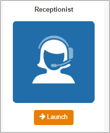
Alternatively it can be accessed from the following link which can be saved in your favourites or you can click the Bookmark this page link on the console.
3.2. - Configuration
The Welcome Email sent to End Users will guide them to navigate to the Business Portal to download/launch the application and set an application password.
The Username for this application is provided in the Welcome email, or alternatively this can always be seen in the Business Portal under the Applications tab. Please note the Username is the same for all applications accessed or downloaded from the Business Portal.
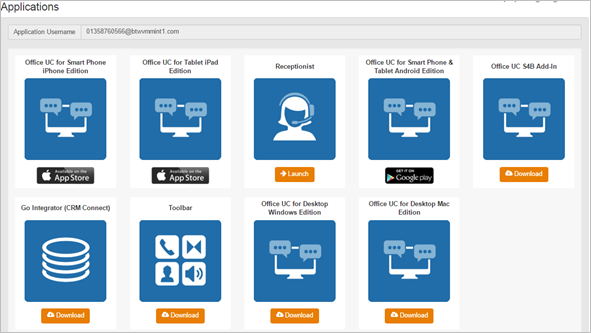
The password for all applications is not sent to the User and needs to be set in the Business Portal by navigating to My Account,

Select Password to Change box, then click on Application, enter password and then select Save.

You can use the Settings link at the top right-hand corner of the main page to access the Settings page where you can configure various aspects of the Receptionist application.
NOTE: Do not use the internet browser’s Back button to return to the main interface.
This section describes the Settings pages that you use to configure Receptionist:
- Settings – General
- Settings – Application
- Settings – Services
- Settings – Plug-ins
- Settings – Messaging
- Settings – About
3.2.1. - Settings - General
You use the General tab to configure miscellaneous settings that improve the usability of Receptionist.
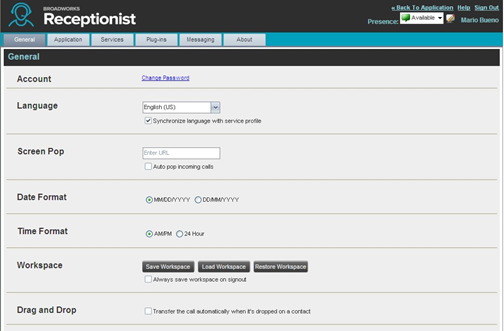
The following subsections describe the settings that can be configured on this page.
3.2.1.1. - Account
This section gives you the opportunity to change your password but it should not be used as it will change all of your applications passwords. All password changes should be completed in the Business Portal only.
3.2.1.2. - Language
The Language settings allow you to select the language of the user interface.
- The drop-down list identifies the languages available in your edition of Receptionist. To change the language, select a new language from the list.
- Synchronize language to my profile – When this option is checked, Receptionist synchronizes the language with your ICtalk3 profile and ignores the language selection on this page.
3.2.1.3. - Screen Pop
You use the Screen Pop settings to configure the URL that may be launched on incoming calls.
- Enter URL – This text box allows you to enter the URL address of the web page that Receptionist opens using the default browser when you click the Web Pop URL button in the Call Notification pop-up window.
- Auto pop for Incoming Calls – When this option is checked, Receptionist launches the Web Pop URL without your being required to click the Web Pop URL button in the Call Notification pop-up window for each incoming call.
The URL can point to any URL address, but typically points to a web application that parses optional call parameters and passes them to a Customer Relationship Management (CRM) application or other database. For example:
http://www.mysite.com/webapp.php?remoteNumber=__REMOTE_PHONE__&sp=__S ERVICE_PROVIDER__
This URL passes the incoming calling number and the service provider ID to the web application at www.mysite.com. The web application formats the data for the applicable database and launches the web page on your PC.
There are a number of optional parameters that the client can pass to the browser. The following list summarizes these parameters:
|
− |
__USER__: The user’s ICtalk3 ID (Note that in this case, the “user” is the ICtalk3 subscriber.) |
|
− |
__FIRST__: The first name of the user |
|
− |
__LAST__: The last name of the user |
|
− |
__EMAIL__: The e-mail address of the user |
|
− |
__GROUP__: The name of the ictalk3 group to which the user belongs |
|
− |
__SERVICE_PROVIDER__: The name of the ICtalk3 service provider to which the user belongs |
|
− |
__PHONE__: The phone number of the user |
|
− |
__REMOTE_PHONE__: The phone number of the remote party |
|
− |
__REMOTE_NAME__: The name of the remote party (when available) |
|
− |
__CALL_TYPE__: “Incoming” or “Outgoing” |
|
− |
__DNIS_NAME__: The name of the DNIS on which the call was received |
|
− |
__DNIS_PHONE__: The phone number of the DNIS on which the call was received |
|
− |
REDIRECTED_NAME_1__ , __REDIRECTED_NAME_2__, and so on: The name of a party to whom the call was redirected prior to being delivered to you, from the most recent to the least recent |
|
− |
__REDIRECTED_PHONE_1__, __REDIRECTED_PHONE_2__, and so on: The phone number of a party to whom the call was redirected prior to being delivered to you, from the most recent to the least recent |
|
− |
__REDIRECTED_USERID_1__, __REDIRECTED_USERID_2__, and so on:
The user ID of a party to whom the call was redirected prior to being delivered to you, from the most recent to the least recent |
NOTE: The maximum number of redirections that can be displayed on a Web Pop URL page is configured by your administrator.
3.2.1.4. - Date Format
This setting allows you to select the format to use for displaying the date in the calendar details for a contact and in the Call History dialog box. The possible options are:
- MM/DD/YYYY
- DD/MM/YYYY
3.2.1.5. - Time Format
This setting allows you to select the format to use for displaying the time in chat windows and in the calendar details for a contact and in the Call History dialog box. The possible options are:
- AM/PM
- 24 hours
3.2.1.6. - Workspace
Receptionist allows you to customize elements of your workspace, such as the size and placement of the main window on the desktop. The system remembers the setup between sessions.
The following elements can be customized:
- The size and position of the web browser window in which the main interface is displayed
- The size of the panes (Call Console, Contacts, and Queued Calls)
NOTE 1: This functionality does not work in Internet Explorer, due to a technical limitation of Internet Explorer.
NOTE 2: When a window is vertically resized, the panes do not always resize to fill the window. To resize a window, drag the window from the bottom right-hand corner or collapse and then expand the panes after resizing to adjust them to the window.
Buttons:
- Save Workspace – This button, when clicked, saves the current workspace.
- Load Workspace – This button, when clicked, arranges your workspace according to the last saved configuration.
- Restore Workspace – This button, when clicked, restores the workspace to the system default configuration.
- Always save workspace on signout – When you sign out from the client, Receptionist asks you whether you want to save your current workspace. To save your workspace automatically when signing out without being asked, check the Always save workspace on signout
To customize your workspace:
- Arrange the windows the way you like.
- Click the Save Workspace button to save the current configuration. To restore the system default, click Restore Workspace.
- At any time to return to the last saved configuration, click the Load Workspace
3.2.1.7. - Drag and Drop
You use the Drag and Drop area to specify whether a call should be automatically transferred when dropped on a contact.
- Transfer the call automatically when it’s dropped on a contact – This setting allows you to enable or disable automatic call transfer when you drag and drop. When this box is checked, the call is automatically transferred to the contact’s phone number when the call is dropped on the contact.
3.2.2. - Setting Application
You use the Application tab to configure your availability to take calls as well as the policies used to process calls.The settings can be configured on this page and are described in the following subsections.
3.2.2.1. - Queue Membership
These settings allow you to select which queues you want to join.
To join queues:
- To join a specific queue, select the check box on the line for the queue.
- To join all queues, select the check box in the column header.
NOTE: If you are not allowed to join/leave a queue, the line for the queue is dimmed and you can only view your join status in the queue. To change your join status in a queue if you are not allowed to do it yourself, contact your administrator.
For queues on this page, you can select columns to appear and you can sort and group queues by any column.
3.2.2.2. - Operator Policies
The Operator Policies setting allows you to select your post sign-in state in your queues.
Post Sign-In ACD State – This drop-down list allows you to select your availability to receive calls from queues upon signing in to Receptionist.
3.2.3. - Settings – Services
You use the Services tab to configure various services assigned to you by your administrator on ICtalk3, which are applicable to Receptionist. These settings are only available if you have been assigned such services. For more information, see your administrator.
The services are grouped into two categories: Active and Inactive.The services that you can configure (if you have been assigned the services) are:
- Do Not Disturb – When you activate this service, you are not available to take calls, and all your calls are automatically sent to your voice mail.
- Call Forwarding Always – When you activate this service, you need to provide the phone number to which your calls are forwarded. When the service is active, all your calls are forwarded to the specified number.
To activate a service:
- Select the service and check the Active The service is moved from the Inactive to Active category.
- If you enabled the Call Forwarding Always service, in the Forward To text box that appears, enter the phone number to which your calls are forwarded.
- To generate a ring splash for incoming calls, check the Ring Splash
- To save your changes, click Save.
3.2.4. - Settings – Plug-ins
You use the Plug-ins tab to configure the plug-in software used by Receptionist to provide functionality such as call notification, LDAP and Outlook directories, program shortcuts, and call logs.
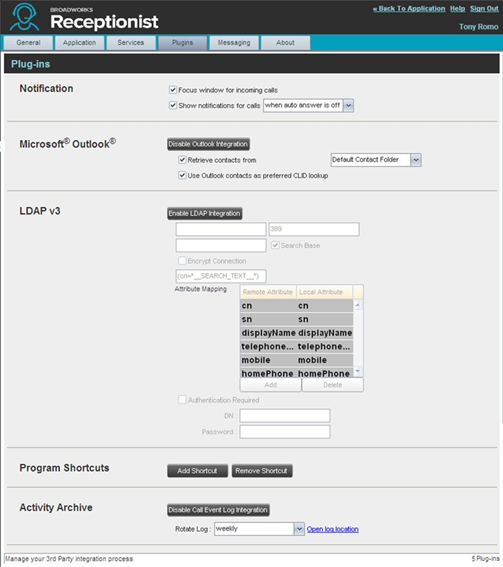
3.2.4.1. - Notification
These options control when and how incoming call notification “pop-up toasts” are displayed. The options you can set are as follows:
- Focus window for incoming calls – When this option is checked and the browser window running Receptionist is minimized, Receptionist automatically restores the window on incoming calls.
This does not work in Firefox. In Internet Explorer, there must be only one tab open in the web browser running Receptionist.
- Show notifications for calls – When this option is checked, Receptionist displays the Call Notification pop-up window on top of other applications’ windows when you receive a call. When you check this box, you need to select an option from the dropdown list to specify the condition under which notifications are displayed.
This does not work if there are other tabs open in the same web browser window as Receptionist. In addition, if calls come within eight seconds of each other, the Call Notification pop-up window only appears for the first call of that series.
3.2.4.2. - Microsoft Outlook
The Microsoft Outlook options control Outlook integration with Receptionist. They are only visible if Outlook integration is enabled in Receptionist.
The options you can set are as follows:
- Enable/Disable Outlook Integration – This determines whether Receptionist integrates with Outlook to provide you with access to your Outlook contacts. If Outlook integration is disabled, the corresponding desktop plug-in software components are not downloaded from ICtalk3.
- Retrieve contacts from – This option allows you to specify where to look for your
Outlook contacts.
- Use Outlook contacts as preferred CLID lookup – When this option is checked, Receptionist uses Outlook to try to identify a caller, when the caller ID is unknown.
NOTE: The Outlook Integration feature provides the following functionality: CLID lookup, saving vCards, and accessing and searching Outlook contacts. When using Microsoft Outlook 2010 or 2013 (32- or 64-bit edition), Outlook has to be running before Receptionist is launched for these functions to work.
3.2.4.3. - LDAP v3
LDAP settings allow you integrate an LDAP directory with Receptionist. These options are only visible if LDAP integration is enabled in Receptionist. If you do not know the appropriate settings, contact your system administrator.
Make sure you have correctly imported a valid certificate in the Java Keystore (JKS) with the keytool.
To import a certificate:
- Click Start and then select Run…
- Type “cmd” and click OK.
- Type “<Java Runtime Path>\bin\keytool -import -alias <aliasname> -file
<path><certificate file name> -keystore %JAVA_HOME%\jre\lib\security\cacerts”.
To verify the certificate:
- Click Start and select Run…
- Type “cmd” and click OK.
- Type “<Java Runtime Path>\bin\keytool -printcert -file <path><certificate file name>”.
The LDAP directory options are as follows:
- Enable/Disable LDAP Integration – This determines whether Receptionist provides LDAP directory lookup services. Clicking the Enable LDAP Integration button enables the controls for LDAP settings.
- LDAP Hostname – This is the network address of the LDAP server.
- LDAP Port – This is the port number for the LDAP server. This is compulsory and can be obtained from your system administrator.
- Search Base – The text box determines the location in the LDAP server tree that Receptionist looks in when executing a search. The check box, when checked, searches all sub-trees within the search base until the specifications are found.
- Encrypt Connection – This option determines whether Receptionist uses encryption when connecting to the LDAP server. Note that if encryption is enabled, you may have to use of a different port.
- ("cn=_ _Search_ _Text") – This option specifies an additional search filter to apply to all directory searches. For example, to include the search criteria in the filter you must
- include (cn=*__SEARCH_TEXT__*). Alternatively, in another example, “(telephoneNumber=*)” restricts search results to users who have a telephone number assigned.
- Attribute Mapping – This table controls the way that Receptionist maps attributes returned from the directory server to columns displayed in the list of search results.
In each row of the table, enter an LDAP attribute in the Remote Attribute column. Enter a corresponding local attribute in the Local Attribute column. Typical Remote Attribute values are “cn”, “sn”, “telephoneNumber”, “mobile”, “homePhone”, and “mail”.
- Authentication Required – When this box is checked, Receptionist must provide a user name and password to the directory server to conduct searches.
- DN – This is the user name Receptionist uses when connecting to the LDAP server when Authentication Required is checked.
- Password – This is the password that corresponds to the authentication DN.
3.2.4.4. - Program Shortcuts
You use the Program Shortcuts settings to create Receptionist shortcuts on your desktop for convenient access to Receptionist.
The program shortcuts plug-in allows for the creation of a desktop shortcut on a Windows platform, which when clicked, launches Receptionist in your default web browser.
- Add Shortcut – This button, when clicked, creates a Receptionist shortcut on your desktop.
- Remove Shortcut – This button, when clicked, removes the previously created Receptionist shortcut. If you did not create a shortcut using the Add Shortcut button, the Remove Shortcut button has no effect.
3.2.4.5. - Activity Archive
This Call Event Log plug-in software provides the ability to store call event statistics locally on your computer.
- Enable/Disable Call Event Log Integration – This double-action button allows you to enable or disable log archival on your computer.
- Rotate Log – This parameter allows you to specify the frequency with which the log is rotated. You select the frequency from the drop-down list.
- Open Log Location – This link, when clicked, goes to the location on your computer where the log is stored.
The log is saved at the desired interval as a comma-separated value (CSV) file in the following path:
<Drive>:\Documents and Settings\<Windows_Username>\Application Data\BroadSoft\BW Receptionist\profiles\<BW_UserID>\statistics
where:
− Drive is the drive letter where your profile is stored (typically C).
− Windows_Username is your Windows user name.
− BW_UserID is your ICtalk3 user ID.
The following events are captured based on activity that occurs on the Receptionist client.
|
Statistic |
Description |
Allowed Values |
Example Value |
|
ICtalk3 User ID |
ICtalk3 user ID |
String |
jsmith@abc.net |
|
Call Center ID |
Call Center ID for inbound queued calls only |
String, null |
ABCSales |
|
Availability |
Operator’s joined state |
Joined, Not Joined, null |
Joined |
|
ACD State |
Operator’s ACD state. Typically, operators should always be Available. This value cannot be changed in Receptionist. |
Sign-On, Available, Unavailable, Wrap-Up, Sign-Out, null |
null |
|
Call ID |
ID of the call |
String, null |
192.168.1.5:1 |
|
Call State |
State of the call |
Idle, Incoming, Outgoing, Active, Held, Remote Held, Detached, Released, null |
Incoming |
|
Personality |
The personality of the call. It indicates whether the user originated this call or whether the call was placed to the user. |
Integer (0, 1, 2)
|
0 |
|
Remote Name |
External caller name |
String or null |
null |
|
Remote Number |
External caller number |
String or null |
5555551234 |
|
Last Redirected Name |
Last redirected name |
String or null |
Jane Doe |
|
Statistic |
Description |
Allowed Values |
Example Value |
|
Last Redirected Number |
Last redirected number |
String or null |
null |
|
Time |
Date stamp of record |
Long date/time format |
2008-04-03 12:08:17.859 |
NOTE: Each row in the archive file records a single event change and as such, columns such as Availability, ACD State, and Call State may contain null values since an alternate column value caused the event change. For example, Incoming is stored in Call State while Availability (and other columns) store null.
3.2.5. - Settings – Messaging
The Messaging tab allows you to configure various messaging options for Receptionist. Currently, e-mail messaging and instant messaging are supported.
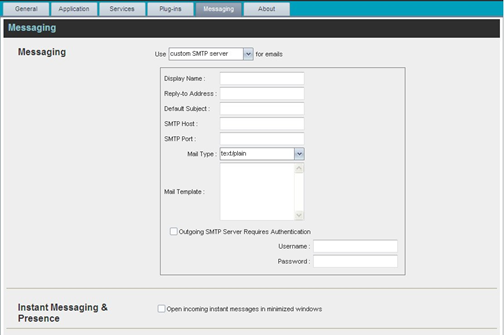
3.2.5.1. - Messaging
These options allow you to specify the mail client to use for sending e-mail messages.
From the drop-down list, select the mail client to use for e-mails.
If you selected the custom SMTP server option, you also need to configure the following options:
- Display Name – This is the name that is displayed in the From
- Reply-to Address – This is the address where reply messages can be sent.
- Default Subject – This is the subject that appears when you generate an e-mail message in Receptionist.
- SMTP Host – This is the IP address of the SMTP host.
- SMTP Port – This is the port of the SMTP host.
- Mail Template – This is the mail template to use.
- Outgoing SMTP Server Requires Authentication – When this option is set, authentication is required to send e-mails.
- Username – This is the name you must enter to authenticate yourself.
- Password – This is the password part of your authentication credentials.
3.2.5.2. - Instant Messaging and Presence
Check the Open incoming instant messages in minimized windows check box if you want the chat windows that appear when you receive an instant message to be displayed in minimized format.
3.2.6. - Settings – About
Use the About tab to view the information about Receptionist.

The following information is provided on this page:
- Version – This is the software version of the ICtalk3 Receptionist client.
- Profile – This is the Receptionist client profile used.
- Disclaimer – This is the Receptionist copyright Information.
3.2.7. - Configure Web Browser
3.2.7.1. - Internet Explorer Settings for Full Screen Mode
Internet Explorer must be configured as follows to enable the Full Screen link in receptionist. Otherwise, the link has no effect; Receptionist is not displayed in full-screen mode when the Full Screen link is clicked and no error message is displayed to the user.
- On the Internet Explorer Menu bar, select the Tools menu and then click Internet Options.
- In the Internet Options dialog box, click the Security tab and then click the Custom level... button
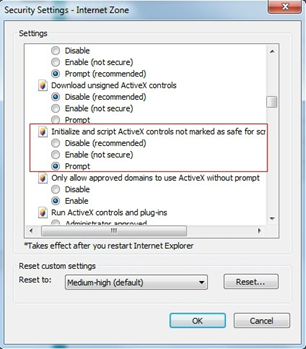
- In the Security Settings – Internet Zone dialog box, scroll down to Initialize and script ActiveX controls not marked as safe for scripting setting in the ActiveX controls and plug-ins
- Select Enable or Prompt.
- Restart Internet Explorer.
3.2.7.2. - Certificate for Desktop Integration Features
You must add the desktop plug-in certificate to the browser-specific certificate store location on your machine, which is required to run Receptionist desktop integration features. For the list of the desktop integration features, see Settings – Plugins.
The following table displays the list of browsers and their respective certificate trust store location.
|
Browser |
Windows |
Mac OS |
|
Chrome |
Windows Certificate Store |
System Keychain |
|
Internet Explorer |
Windows Certificate Store |
Not Applicable |
|
Safari |
Not Applicable |
System Keychain |
|
Firefox |
Firefox Certificate Store |
Firefox Certificate Store |
The following subsections provide instructions for adding the certificate in the different environments.
3.2.7.3. - Download Desktop Plug-ins Certificate
The desktop plug-ins certificate can be downloaded with the following HTTP call to the
Receptionist client context:
http(s)://<host[:port]>/<Receptionist context>/certificate/desktopplugin.cer.
For example:
https://xsp.broadsoft.com/com.broadsoft.receptionist/certificate/desktopplugin.cer
3.2.7.4. - Add Certificate to Microsoft Windows Certificate Store
Follow these steps to add the desktop plug-in certificate to the Windows certificate store.
Method 1 – Using certmgr.msc command:
- Click the Start button, type “certmgr.msc” into the Search box, and then press ENTER.
- If you are prompted for an administrator password or confirmation, type the password or provide confirmation. The Certificate Manager window appears.
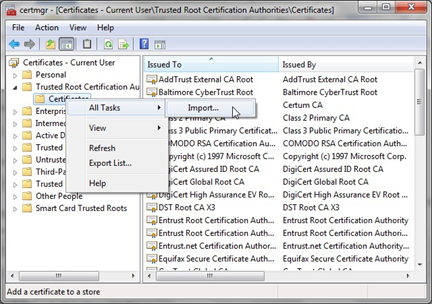
- Double-click the Trusted Root Certification Authorities store to expand it, and then right-click Certificates.
- From the menu that appears, select All Tasks, and then Import. The Certificate Import Wizard dialog box appears.
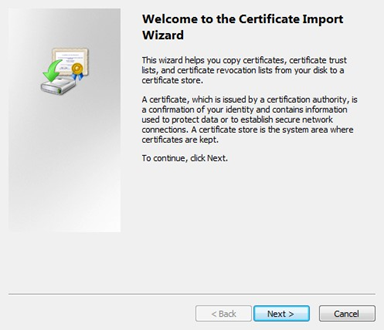
- Follow the instructions of the wizard to install the certificate.
Method 2 – Using Internet Explorer:
- From the Internet Explorer Menu bar, select Tools and then Internet Options. The Internet Options window appears.
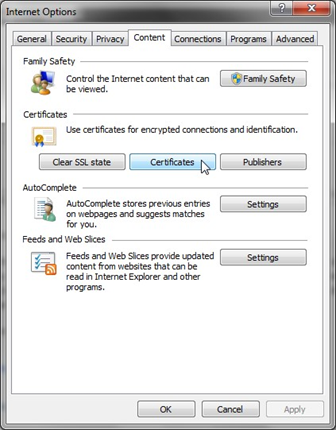
- Click the Content tab and then the Certificates The Certificates window appears.
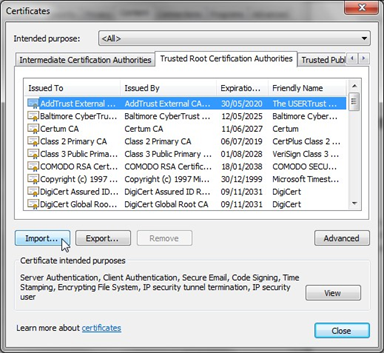
- Click the Trusted Root Certification Authorities tab, and then click the Import The Certificate Import Wizard dialog box appears.
- Follow the instructions of the wizard to install the certificate.
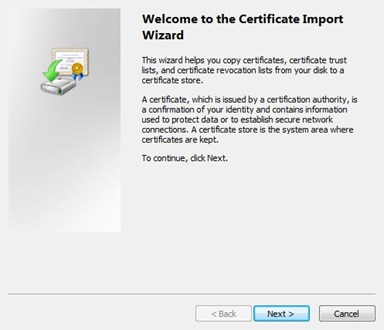
Method 3 – Using Google Chrome:
- Open the Chrome browser.
- In the top right of the browser window, click the Chrome menu .
- Click Settings. The Settings tab appears.
- At the bottom, click Show advanced settings and scroll-down to the HTTPS/SSL section.
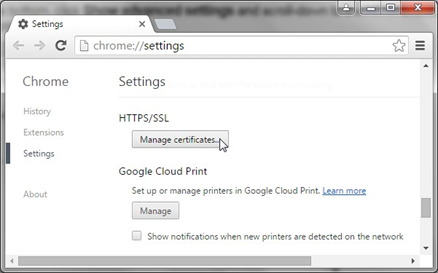
- Click Manage certificates. The Certificates window appears.
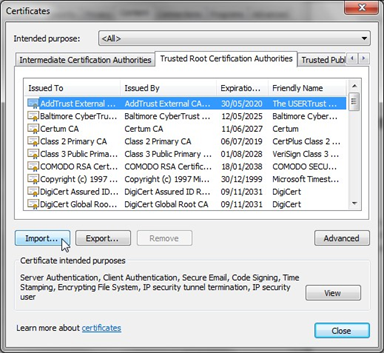
- Click the Trusted Root Certification Authorities tab, and then click the Import The Certificate Import Wizard dialog box appears.
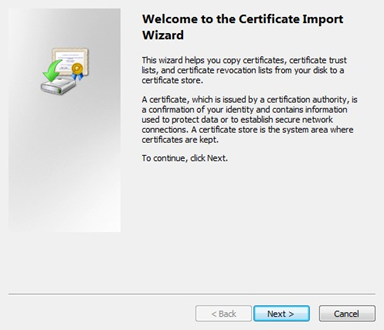
- Follow the instructions of the wizard to install the certificate.
3.2.7.5. - Add Certificate to Apple System Keychain
To add the certificate into the system keychain on a Mac computer, do the following:
- In the Dock, open Finder.
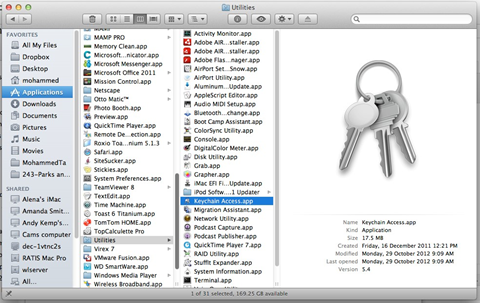
- Select Applications and then Utilities.
- In the list of utilities, double-click Keychain Access. The Keychain Access window appears.
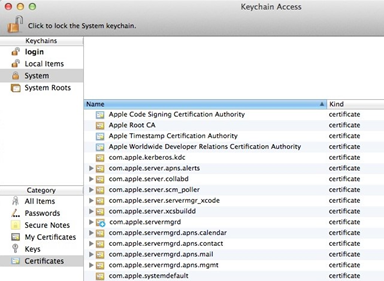
- In the Keychain Access window, under Keychains, click System and then under Category, click Certificates.
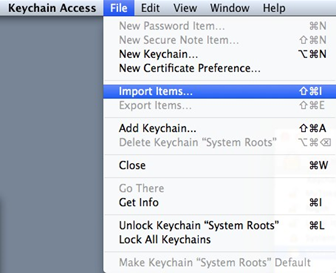
- In the Keychain Access toolbar, select File and then Import Items.
- Follow the instructions of the browser to import the certificate file. The certificate appears in the list of certificates as 127.0.0.1.
- In the Keychain Access window, double-click the certificate. The Certificate windows appears.
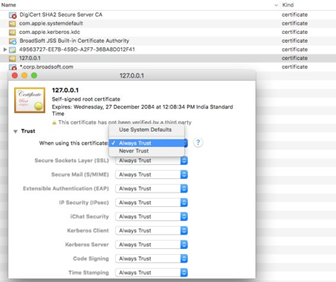
- In the Trust section select Always Trust for When using this certificate.
- Close the browser.
3.2.7.6. - Add Certificate to Firefox Certificate Store
Mozilla Firefox has its own certificate store. Follow these steps to add the certificate to the Firefox Certificate store.
- Open the Firefox browser.
- Open the Options/Preferences window:
- On Windows: From the Tools menu, select
- On Mac: From the Firefox menu, select Preferences.
The Options/Preferences window appears.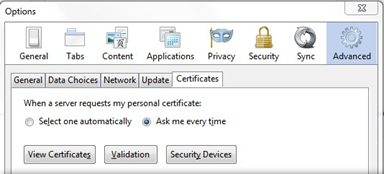
- Click Advanced and then click the Certificates
- Click View Certificates to open the Certificate Manager.
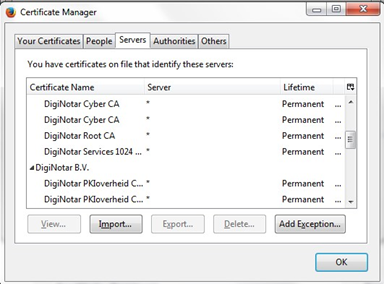
- In the Certificate Manager, click the Servers
- Click Import.
- Select the certificate file on your computer and import it.
- Click the Add Exception
- In the Location textbox, enter https://127.0.0.1:5555/ and click Get Certificate, (assuming that “5555” is the default port of the local HTTPS [127.0.0.1] server).
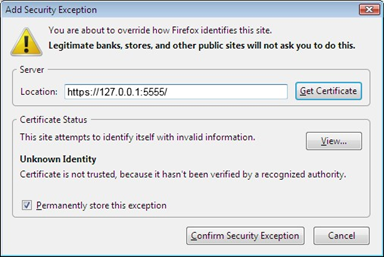
- Click Confirm Security Exception.
- In the Certificate Manager, click OK.
Restrictions and Limitations
3.2.8.1. - JNLP Download
As you sign to Receptionist, a JNLP file is downloaded, and you are asked to click the link shown in the browser. Due to security restrictions, the application may not run. If this occurs, perform the steps specified in the following subsections.
Note that you should run Java JRE 1.6 or higher.
3.2.8.2. - On MAC OS X
In MAC OS X, due to security-related restrictions, the JNLP may not execute even if you click on it. If this occurs, perform the following steps:
- Open System Preferences and select Security and Privacy. The Security & Privacy window appears, displaying the General tab.
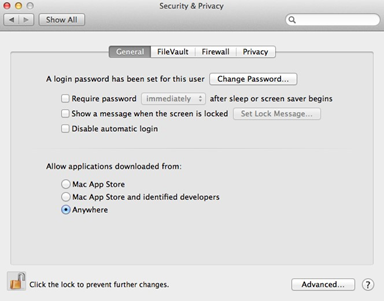
- Unlock the panel with the lock icon.
- In the Allow applications downloaded from section, select Anywhere.
3.2.8.3. - In Internet Explorer
If you are running Internet Explorer 9 or lower, you must perform the following steps to run JLNP.
NOTE: It is recommended to run Receptionist over HTTPS with Internet Explorer.
- From the Internet Explorer Menu bar, select Tools and then Internet Options. The Internet Options window appears.
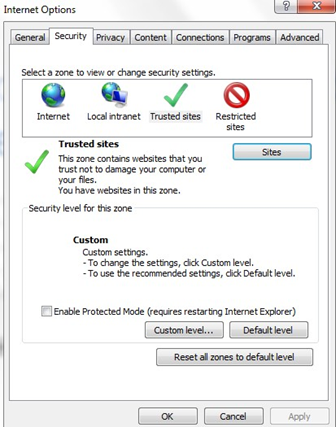
- Click the Security
- Click Trusted sites and then click Sites. The Trusted sites window appears.
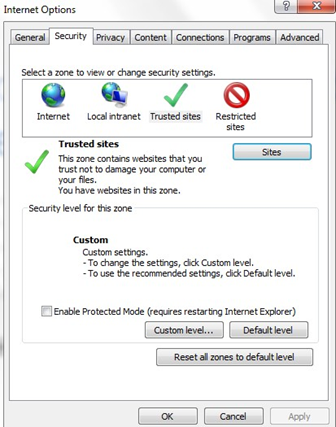
- In the Add this website to the zone text box, enter the Receptionist client URL and click Add. The URL appears in the Websites
- Click Close
- In the Internet Options window, click Custom level. The Security Settings – Trusted Sites Zone window appears.
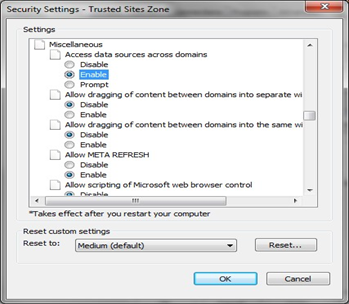
- Scroll down to Miscellaneous settings section and select Enable for the Access data sources across domains.
- Click Yes in the Warning! window that appears.
- Click OK and then click OK in the Internet Options
4 - Operating the Feature
4.1. - Start-up and Login
To log in, navigate to the webpage by launching the application from the Business Portal or by navigating to the following URL: https://applications.yourwhc.co.uk/receptionist/
Enter your Username and Password for the application, followed by the Sign In button. Please note you can only have 1 active session per username, if you logon from a second location, it will automatically log out the first location.
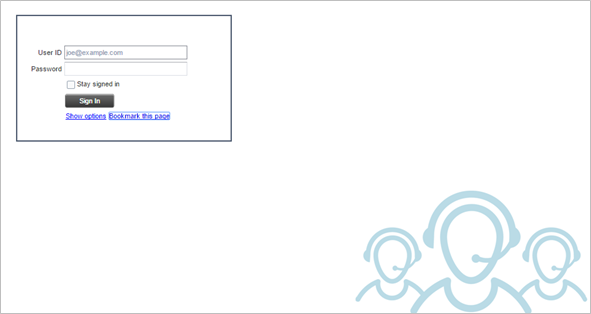
To log out, simply select Sign Out.
This button displays the following states:
- A grey button indicates that you are not logged in.
- A green button shows that you are currently logged in.
- A disabled button shows that Toolbar is attempting to log you in.
- A red button indicates that your last login attempt failed.
4.2. - Start-Up Window
When you sign in to Receptionist, the main page appears where you perform most of your call management and monitoring tasks. In addition, the main page provides a link to the Settings pages, where you configure various Receptionist settings.
Many visual aspects of Receptionist are configurable. For example, you can decide which windows should be open and change the size and placement of windows on the screen. You can then save your workspace and retrieve it the next time you log in.
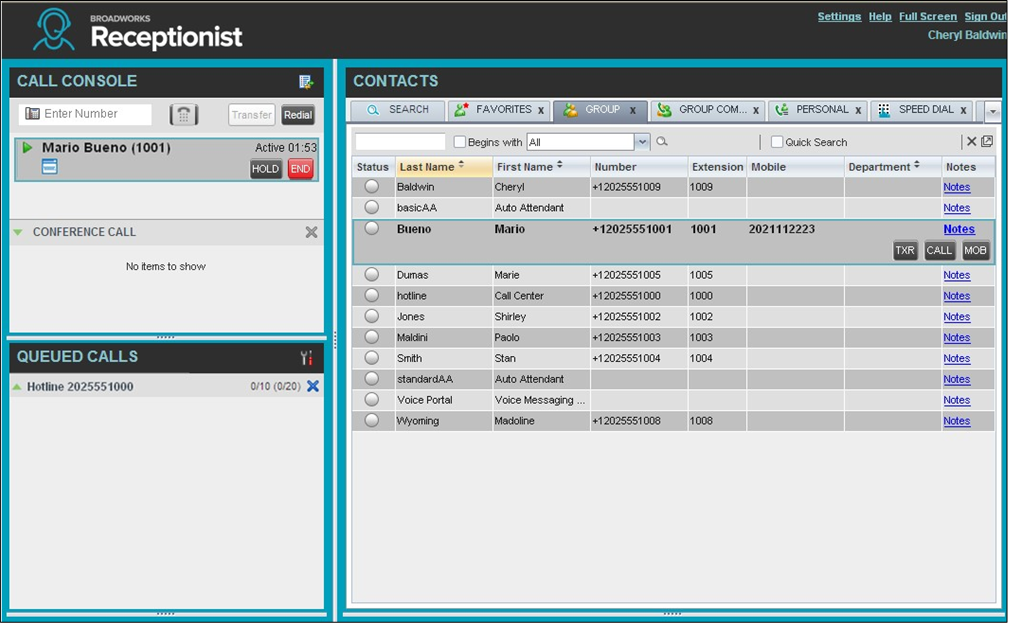
To work in full screen mode, click the Full Screen link in the top-right corner of the main window. The link changes to Exit Full Screen, which you can click to exit full screen mode. Please note:
- To work in full screen mode, you can also click F11 when the main window is in focus.
- The Back, Forward, and Refresh operations of the web browser are not supported by Receptionist; and if performed, the results are inconsistent.
- When a window is vertically resized, the panes do not always resize to fill the window. To resize a window, drag the window from the bottom right-hand corner or collapse and then expand the panes after resizing to adjust them to the window.
You can also resize the Call Console and the Contacts panes by moving the bar between the two to the left or to the right. Receptionist remembers the position of the bar at sign out, and the bar is at the same position the next time you sign in.
Most Receptionist controls are context-based, which means that they appear only when the action they represent can be taken. Context-based controls that allow you to take actions on calls are called action buttons.
4.3. - Change Your IM&P Presence Status
When you sign in to Receptionist, Receptionist connects to the Instant Messaging and Presence (IM&P) server and sets your presence state to “Available”. Subsequently, Receptionist displays your unified instant messaging presence, which reflects your presence in various instant messaging clients when you are logged in through several devices and applications.
Your unified presence state can change either when you manually change it or when Receptionist receives information about your presence state change from other clients. The possible states are Available, Busy, Away, and Offline. When you are in the Available, Busy, or Away state, you are considered to be online. Receptionist also allows you to provide a status message to display to your contacts.
To change your presence state
- Click the Presence box at the top right-hand side of the main window and select the new state from the drop-down list.
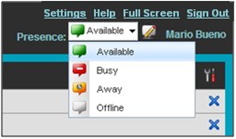
When you are online, you can set a status message to display to your contacts. To set an IM&P status message:
- Click the Edit button
 next to the Presence The Set IM Status dialog box appears.
next to the Presence The Set IM Status dialog box appears.

- Enter your message and click OK.
- To see your message, move the mouse over the Edit button
 . A ToolTip with your presence massage appears.
. A ToolTip with your presence massage appears.

4.4. - Call Console
You use the Call Console to view and manage your current calls.
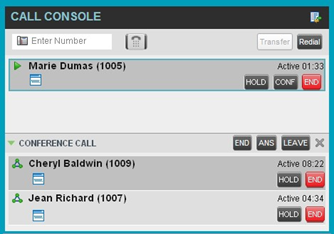
The Call Console contains the following areas:
- Header
- Dialer
- Current Calls
- Conference Call Panel
4.4.1. - Header
The Call Console header contains the following controls:
- Call History button
 – This allows you to access the list of your previous calls.
– This allows you to access the list of your previous calls. - Call Waiting button
 – This allows you to enable the Call Waiting service.
– This allows you to enable the Call Waiting service. - Auto Answer button
 – This allows you to answer your calls automatically.
– This allows you to answer your calls automatically.
4.4.2. - Dialer
The Dialer, located at the top of the Call Console, below the header, allows you to make ad hoc calls.

- The Enter Number text box is where you enter the number to dial.
- The buttons to the right, called action buttons, change depending on the context, and allow you to perform operations on calls.
4.4.3. - Current Calls
The Call Console displays your current calls and allows you to take actions on them.
If you are involved in a conference call, its details are displayed in the Conference Call panel at the bottom of the Call Console. The Conference Call panel is described in the following section.
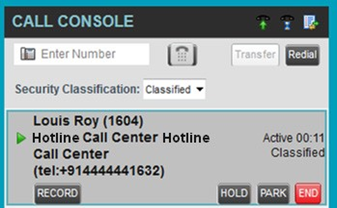
Each call is listed on a separate line with the following information:
- Remote CLID – This is the name of the remote party (if available) and the phone number in parenthesis.
- For a recalled call, the following information appears:
Recall: <caller’s name="">; via:
- For a recalled call, the following information appears:
- Diversion CLID – This is the name (if available) of the party who diverted (transferred or forwarded) the call before you received the call and the phone number is in parenthesis. If the call was diverted more than once, the last party who diverted the call is listed first; the second to last party is listed second; and so on.
- Call State icon – This is a visual representation of the current state of the call.
- Call State name – This is the display name of the state the call is currently in.
- Call duration [Held duration] – This is the duration of the call from the time the call was received from the system and it accurately reflects how long the call has been present in the system. In addition, for held calls, the time a call has been on hold is also displayed.
- Action buttons – These buttons are for the operations that you can currently take on the call.
4.4.4. - Conference Call Panel
The Conference Call panel displays your current conference and allows you to manage your 3-way conference calls. You can only be involved in one conference call at a time.

The header bar contains various controls that allow you to manage the conference:
- Hold Conference button
 – This allows you to place the conference on hold.
– This allows you to place the conference on hold. - Resume Conference button
 – This allows you to resume a held conference.
– This allows you to resume a held conference. - Leave Conference button
 – This allows you to leave the conference.
– This allows you to leave the conference. - End Conference button
 – This allows you to end the conference.
– This allows you to end the conference.
The panel lists the call legs that make up your current conference. Each two-way call is displayed on a separate line. The information displayed for each call leg is the same as the information displayed for a two-way call.
4.4.5. - Call States and Actions
The following table lists the possible call states and actions that can be performed in each state.
|
Call State |
Display Name |
Display Icon |
Call Personality |
Call Actions |
|
Ringing In (Local) |
Incoming Local |
|
Click-To-Dial |
Answer, End |
|
Ringing In (Remote) |
Incoming |
|
Terminator |
Answer, Conference, End |
|
Ringing Out, Outgoing |
Outgoing |
|
Originator |
Conference, End |
|
Active |
Active |
|
Any |
Transfer, Hold, Park, Camp, End, Conference |
|
On Hold |
Held |
|
Any |
Transfer, Resume, Park, Camp, End, Conference |
|
On Hold (Remote) |
Remote Held |
|
Any |
Transfer, Hold, End, Conference |
|
Active (In Conference) |
Active |
|
Conference |
Transfer, Hold, End |
|
Held (In Conference) |
Held |
|
Conference |
Resume, Transfer, End |
|
Ringing In (Recalled Call) |
Recalled |
|
Terminator |
Answer, Conference, End |
|
Parked Call |
Parked (<DN>) |
|
Any |
Answer, End |
4.5. - Contacts Pane
The Contacts pane contains your contact directories in a tabbed format and allows you to use your contacts to make or manage calls.
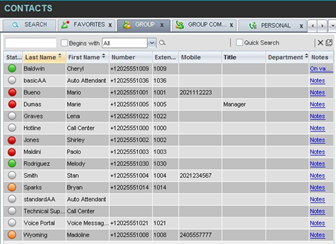
- Directory Management Bar
- Directories List
- Search Tab
- Favourites Tab
- Enterprise Tab
- Enterprise Common Tab
- Monitored Contacts Tab (Enterprise Edition)
- Personal Tab
- Speed Dial Tab
- Queues Tab (Enterprise Edition)
- Custom Directories Tabs (Enterprise Edition)
- Instant Message Tab
-
4.5.13. - Outlook Tab Enterprise Edition
(Enterprise Edition) - Search Results Tabs
You can only see the contents of one directory at a time. The information displayed for a contact, depends on the directory, which is described in the following subsections.
When you click a contact in any contact directory, the contact expands and the action buttons for the operations that you can currently perform on that contact, and in some cases additional information about the contact appear.
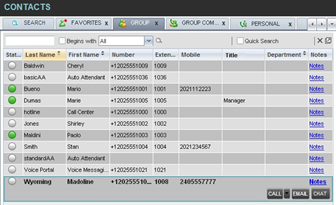
4.5.1. - Directory Management Bar
The Directory Management bar contains controls that allow you to perform search operations, create directories from search results, and edit directories.

4.5.2. - Directories List
The drop-down arrow to the right of the directories tabs, when clicked, displays the list of directories available to you, and allows you to select directory tabs to display in the Contacts pane.
4.5.3. - Search Tab
You use the Search tab to look for specific contacts in all your contacts directories and in the configured LDAP directory. The search results can contain contacts from several directories, and the following information can be displayed for each contact (as applicable): phone state, IM&P state, contact name, and the directory where the contact was found.
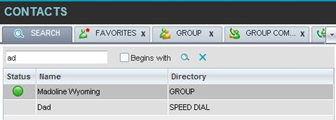
4.5.4. - Favourites Tab
You use the Favourites tab to monitor the phone state of selected contacts. The Favourites directory provides the following information for each contact (as applicable): call state, last and first name, phone number, extension, mobile number, department, and link to notes.
The contacts to monitor must be configured on the web portal. This is referred to as static monitoring.

4.5.5. - Enterprise Tab
The Enterprise tab contains all contacts build on the Business Portal and includes all Enhanced Group Features that have numbers.
The following information is displayed for each contact: (as applicable): call state, last and first name, phone number, extension, mobile number, department, and link to notes
4.5.6. - Enterprise Common Tab
This tab is not used and will be removed in a future release.
As a temporary workaround you can select the x button to close the tab and then save the workspaces on exit. This will stop it displaying.
Group COM Tab (Enterprise Edition)
The Group Com (Monitored Contacts) directory contains the contacts that you are dynamically monitoring, and are those that are included in the Business Portal Group Directory.
The information displayed for each contact includes the contact’s name and number, as you configured them on the Business Portal.
4.5.8. - Personal Tab
The Personal tab contains all contacts build in Business Portal under the uses Personal directory.
The information displayed for each contact includes the contact’s name and number, as you configured them on the Business Portal.
4.5.9. - Speed Dial Tab
The Speed Dial tab displays your Speed Dial 8 and Speed Dial 100 contacts.
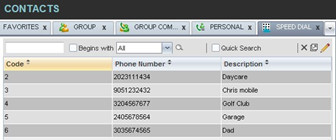
The information displayed for each contact includes the speed dial code, phone number, and description, as you configured them on the Business Portal.
Queues Tab (Enterprise Edition)
The Queues tab displays the list of call centers and associated DNIS numbers that a call center agent or supervisor is staffing and/or supervising. The primary purpose of this directory is to provide you with a quick way to transfer calls to queues.
The information displayed for each queue includes the name, phone number, extension. The Group button allows you to group (and ungroup) queues by call center.
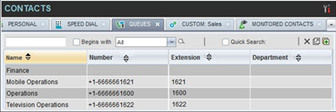
Custom Directories Tabs (Enterprise Edition)
If you create a Company Directory on the Business Portal then this will appear here. If this has not been set-up, then this will not be displayed. Custom directories allows you to create a bespoke list of contacts from the Enterprise directory.
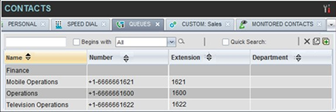
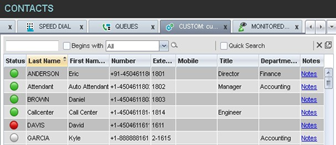
4.5.12. - Instant Message Tab
The Instant Message tab displays IM&P contacts to which you have are subscribed. The information displayed for each contact includes the contact’s name, IM&P ID, and unified IM&P presence state.
When your presence state is set to “Offline”, the tab is empty.
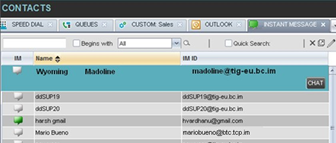
4.5.13. - Outlook Tab Enterprise Edition
(Enterprise Edition)
The Outlook Tab Enterprise Editioncontains your Outlook contacts. The information displayed for each contact includes the contact’s last and first name, phone number, mobile number, and home phone number. This feature is available to you if you have the Outlook Integration feature enabled and configured from the Settings page.

4.5.14. - Search Results Tabs
When you perform a search on a directory, you can keep the results of the search and save them in a new contacts directory. The name of the new directory is the same as the name of the directory on which the search was performed, but the directory icon has an arrow similar to the arrow used on shortcut icons 
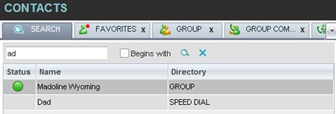
NOTE: A search results directory has the same properties as the original directory, and you can perform the same operations on contacts in a search results directory as in the original directory. You can perform a search on a search results directory and keep the results under another tab. The number of search results directories you can create is limited to ten. Search results directories are only available for the current sign-in session. In addition, once closed, they cannot be restored. If required, perform the same search again.
4.6. - Queued Calls Pane (Enterprise Edition)
You use the Queued Calls pane to manage queued calls in the selected call centers. The pane lists queued calls for the selected call centers. Each call center is displayed in a separate panel. The panel’s header displays the following information:
- The name of the call center
- The primary phone number of the call center
- The number of calls currently displayed for the queue against the maximum number of calls that can be displayed for a queue.
- The number of calls in queue against the queue length
A Message Waiting icon  indicates that there are outstanding messages for the call center.
indicates that there are outstanding messages for the call center.
When you expand the panel for a call center, the list of calls queued in that call center appears, with calls listed according to their position in the queue.
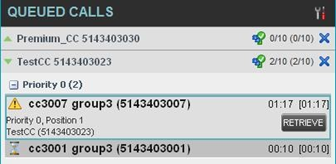
The following information is provided for each call:
- Call Status icon - A graphic representation of the state of the queued call, which can be one of the following:
- Waiting
 – The call is queued, waiting to be answered.
– The call is queued, waiting to be answered. - Announcement
 – An announcement is being played to the caller.
– An announcement is being played to the caller. - Reordered
 - The position of the call in the queue has been changed.
- The position of the call in the queue has been changed. - Bounced
 - The call has been bounced.
- The call has been bounced.
- Waiting
- Name (if available) and phone number of the calling party.
- The total call time, including the time in the current priority bucket (in parentheses).
Clicking a call expands the call to show additional data:
- Position of the call in the queue.
- The name (if available) and the phone number of the call center (or DNIS, if applicable) that was called.
When you move the mouse over a queued call, the action buttons that can be applied to the call appear.
4.7. - Controls
Receptionist controls are designed in a contextual manner, that is, most controls appear only when the action they represent can be taken. For example, when you select a call and enter a number or select a contact, the Transfer button appears, allowing you to transfer the call. The controls that correspond to call operations, such as Dial, Transfer, or Hold are called action buttons.
The following table lists the general controls used in Receptionist and the controls displayed on the headers in the panels, windows, or tabs.
|
Name |
Description |
|
Common Controls |
|
|
|
This allows you to organize items in lists. |
|
|
This shows or hides the contents of a window, panel, or tab. |
|
|
This closes an interface element, such as window, pane, tab, or panel. |
|
|
This allows you to edit contacts in some directories. |
|
Name |
Description |
|
Call Console Controls |
|
|
|
This displays your call logs. |
|
|
This allows you to turn Call Waiting on or off. |
|
|
This automatically answers your incoming calls. |
|
|
This ends a conference call. |
|
|
This allows you to leave the conference while allowing other participants to continue the call. |
|
|
This places a conference call on hold. |
|
|
This resumes a held conference. |
|
|
This opens a page in your browser at the configured URL to provide additional information about the caller. |
|
|
This places directory search results in a new tab. |
|
|
This clears the search results. |
|
|
This groups queues by call center. |
|
Call Notification Pop-up Window |
|
|
|
This opens a page in your browser at the configured URL to provide additional information about the caller. |
|
|
This saves the caller’s phone number and personal information as a vCard in Microsoft Outlook. |
|
|
This transfers an incoming call to your voice mail. |
|
Chat Window |
|
|
|
This places a call to your chat partner. |
|
|
This allows you to select users to add to the chat. |
|
|
This invites selected users to the chat. |
|
|
This takes a chat window out of the main interface and makes it a free-floating window. |
|
|
This anchors a free floating chat window inside the main interface. |
|
Name |
Description |
|
|
This minimizes the chat window. |
|
|
This closes the chat window. |
4.7.1. - Call Action Buttons
Action buttons allow you to perform actions on calls, such as answering or transferring a call, or actions that result in a call being placed, such as dialing a number or contact. They appear on the Dialer, a call line, a call history log, or a directory entry.
Action buttons are contextual, that is, they appear on a line/entry only when you move the mouse over that entry and when the corresponding action can be performed on that entry (with the exception of the Mon button on virtual user entries).
NOTE: Virtual users cannot be monitored even when the Mon button appears on expanded virtual user entries.
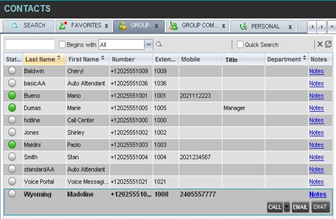
The following table lists action buttons available in Receptionist.
|
Button |
Description |
|
|
This dials the number you entered in the Dialer. |
|
|
This places a call to the selected contact or to a number from Call History. |
|
|
This redials the last dialed number. |
|
|
This dials the contact’s mobile number. |
|
|
This brings up a new e-mail message window with the contact’s e-mail address, allowing you to send an e-mail to the contact. |
|
|
This transfers a call to an ad hoc number entered in the Dialer. |
|
|
This transfers a call to a selected number or contact. |
|
|
This transfers a call to the selected contact’s voice mail. |
|
|
This answers an incoming call, answers an unanswered call for a contact, or resumes a held call. |
|
|
This places a call on hold. |
|
|
This ends a call. |
|
|
This establishes a conference call or adds a call to a conference. |
|
|
This camps the call on a busy contact. |
|
|
This barges in on a contact’s call. |
|
|
This parks a call on a contact. |
|
|
This records a call. |
|
|
This pauses call recording. |
|
|
This resumes call recording. |
|
|
This stops recording a call. |
|
|
This starts monitoring the state of the selected contact, except if the contact is a virtual user. Virtual users cannot be monitored. |
|
|
This opens a chat window allowing you to chat with an IM&P contact. |
|
|
This promotes a selected call to the next higher priority bucket. |
|
|
This retrieves a selected call from the queue to the supervisor’s device. |
|
|
This changes a selected call’s position in the queue. |
|
|
This opens a page in your browser at the configured URL to provide additional information about the caller. |
|
|
This deletes a call log from Call History. |
4.8. - Manage Calls
This section includes information and procedures on how to manage current calls. You use the Call Console to view and manage your current calls.
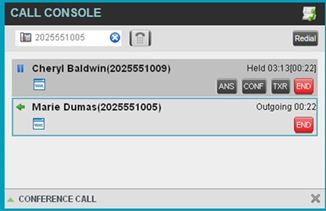
Drag and Drop Call onto Contact
For operations on calls that involve a contact, you can drag a call from the Call Console and drop it on a target contact in one of your contact’s directories. This provides you with a quick way to perform operations on calls that involve a contact.
As the call is dragged, a green arrow appears. By default, when the call is dropped onto a contact, no action is taken on the call. The target contact expands and you can select the action button for the operation you want to perform on that call.
However, you can enable automatic call transfer on Drag and Drop (if available). If automatic transfer is enabled, then the call is transferred to the contact’s phone number when you drop the call on the contact.
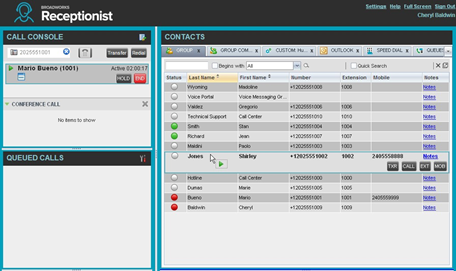
4.8.1. - View Call Information
Call information is provided in the Call Console and in the Call Notification pop-up window that appears on top of the system tray for incoming calls.
4.8.2. - View Current Calls
Your current calls are always visible in the Call Console.
4.8.2.1. - To view your conference call:
In the Conference Call panel, click the Expand button. 
4.8.3. - View Incoming Call Details
If the Call Notification feature is enabled, a Call Notification pop-up window appears on top of the system tray when an inbound call is received.
- Direct inbound calls – For calls to your direct number or extension, the following information is displayed:
- Calling party name
- calling party number
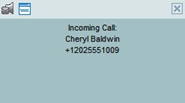
-
In addition, for diverted calls, that is, calls that were forwarded or transferred before being delivered to you, the diversion information is also displayed.
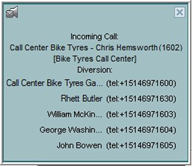
-
NOTE 1: You must have only one tab open in the browser running Receptionist to receive call notifications.
-
NOTE 2: If calls come within eight seconds of each other, the Call Notification pop-up window only appears for the first call of that series.
4.8.4. - Save vCard
When you receive a call, a Call Notification pop-up window is visible on top of the system tray. From this window, you can save the caller’s phone number and personal information as a vCard in Microsoft Outlook.
To save caller’s information as a vCard:
In the Call Notification pop-up window, click the Add vCard button  .
.
This button is present only when Outlook is running.
4.8.5. - Open URL
For any current call, you can open a page in your browser that contains information about the calling party encoded in its URL.
This can be done either from the Call Notification pop-up window that appears on top of the system tray for an incoming call or from the Call Console for any current call.
This feature is configured on the Settings – General configuration page.
To open a URL for the incoming call:
In the Call Notification pop-up window, click the Web Pop URL button  .
.
To open a URL for any call:
In the Call Console, click the Web Pop URL button  for the target call.
for the target call.
4.9. - Answer Calls
You can answer your own incoming calls and calls for other users in your group. If you have the Auto Answer service, you can also answer calls automatically.
4.9.1. - Answer Call
Your incoming calls appear in the Call Console. To answer a call, the call state must be Incoming.
To answer an incoming call:
Move the mouse over the call and click Answer  . The call state changes to Active.
. The call state changes to Active.
NOTE: Double-clicking a call, does not answer it.
To answer an incoming call from a Call Notification pop-up window:
Click anywhere on the text in the window.
To answer calls automatically:
In the Call Console, click the Auto Answer button  . The button changes to this
. The button changes to this  to indicate that Auto Answer is on.
to indicate that Auto Answer is on.
When Auto Answer is enabled, your phone automatically goes off-hook when it is alerted. This applies to both inbound and Click-To-Dial calls.
The Auto Answer feature may be enabled manually in the client or by the administrator on the server.
NOTE: If this feature is enabled by your administrator, you must not enable the client-based Auto Answer using the Auto Answer button.
4.9.2. - Pick Up Call
The Directed Call Pickup service allows you to answer a call that is incoming on another user. Depending on your setup, you can answer calls for users in your group or in the entire enterprise. This is useful when the user is currently not on hand to answer the call.
NOTE: To pick up a contact’s call, you need to have the Directed Call Pickup service assigned.
To answer a call for a contact:
- Expand your Group/Enterprise or Favourites directory and click the target contact to expand it. The contact’s state must be Ringing.
- Move the mouse over the contact and click Answer
 .
.
The call appears as Incoming in the Call Console.
4.10. - Hold and Resume Calls
You can only put an active call on hold.
4.10.1. - Put Call on Hold
- To put a call on hold:
Move the mouse over the call and click Hold .
4.10.2. - Resume Held Call
- To resume a held call:
Move the mouse over the call and click Answer .
NOTE: Double-clicking a call does not take the call off hold.
Make and End Calls
Receptionist provides you with several ways in which you can make calls. When you dial a number or contact, the call appears in the Call Console as Incoming Local.
4.11.1. - Dial Ad Hoc Number
You use the Dialer to place a call to an ad hoc number.

To dial an ad hoc number:
- In the Dialer, enter the phone number and click Dial
 . The call appears in the Call Console as Incoming Local and your phone rings.
. The call appears in the Call Console as Incoming Local and your phone rings. - Click Answer
 for that call. An outbound call is placed and the call state changes to Outgoing.
for that call. An outbound call is placed and the call state changes to Outgoing.
4.11.2. - Redial Number
Receptionist keeps up to ten most recently dialed numbers.
To redial one of the recently dialed numbers:
- In the Dialer, place the cursor in the text box and start entering a number. A list of recently called numbers that start with the entered digits appears.

-
Select the number to dial and click dial.
Alternatively, click the Redial button
The client issues a click -To-Dial attempt to the selected number. and select the number from the list that appears.
and select the number from the list that appears.
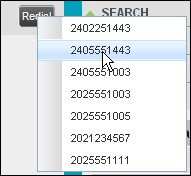
4.11.3. - Dial Contact
You can dial contacts from any directory available in Receptionist.
To dial a contact:
- In the Contacts pane, expand the directory from which you want to dial a contact.
- Click the contact to expand it and click Call
 for that contact. A Click-To-Dial action is initiated and your phone rings.
for that contact. A Click-To-Dial action is initiated and your phone rings.
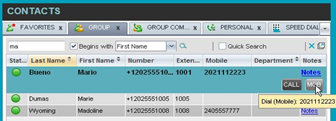
- Answer the phone. An outbound call is placed.
- Alternatively, to dial the contact’s mobile number, click Mobile
 .
.
4.11.4. - Speed Dial
To speed dial a contact:
- In the Contacts pane, click the Speed Dial
- Click the contact to expand it and click Call
 .
.
Dial from History
You can dial any number that is available in Call History.
To dial from Call History:
You can dial any number that is available in Call History.
To dial from Call History:
- In the Call Console, click the Call History button
 . The Call History dialog box appears.
. The Call History dialog box appears.
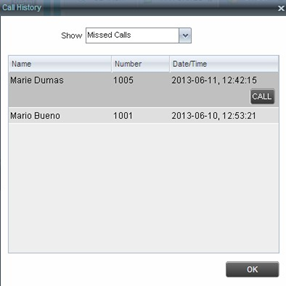
- From the Show drop-down list, select the grouping you want.
- Scroll through the list of call logs to find the entry you need.
- Click the entry to expand it and click Call
 .
.
4.12. - End Call
To end a call:
Click End  for that call.
for that call.
NOTE: If the call has not yet been answered, then the calling party continues to ring until there is no answer, another applicable timer expires, or the user hangs up.
4.13. - Transfer Calls
There are a number of ways that you can transfer a call. You can blind transfer calls or transfer calls with consultation or supervision. You can also transfer calls directly to voice mail or to a queue.
4.13.1. - Blind Transfer Call
A blind transfer occurs when a call is transferred without an introduction. Calls may be blind transferred while active, held, or ringing (in) on your phone. If a call is ringing (in), blind transfer allows the call to be redirected before it is answered. You can blind transfer a call to an ad hoc number or to a contact.
To blind transfer a call to an ad hoc number:
- In the Call Console, select the call to transfer.
- In the Dialer, enter the destination number and click Transfer
 . The call is transferred and removed from the Call Console.
. The call is transferred and removed from the Call Console.
To blind transfer a call to a contact:
- In the Call Console, select the call to transfer.
- In the Contacts pane, click the tab from which you want to select a contact.
- Click the destination contact to expand it, and click Transfer
 for that contact. The call is transferred and removed from the Call Console.
for that contact. The call is transferred and removed from the Call Console.
Alternatively, drag the call onto the target contact and click Transfer  for that contact.
for that contact.
4.13.2. - Conduct Supervised Transfer
When you have an active inbound call that you want to transfer, you can follow this procedure.
To conduct a supervised transfer:
- In the Call Console, select the call to transfer.
- Dial the number or contact to whom you want to transfer the call.
- If the dialed contact is busy, either retry or dial another contact.
- Move the mouse over the new, non-selected call and click Transfer
 .
.
4.13.3. - Transfer with Consultation
Use this method to transfer a call with an introduction to the destination party. Calls may be transferred this way while active, held, or ringing (in) on your phone. In the latter case, the system redirects the call before it is answered.
To transfer a call with consultation:
- Make a call to the person to whom you want to transfer the call. If the first call was active, it is put on hold. The new call appears in the Call Console.
- Wait until the called party accepts your call and speak to the party.
- When ready to transfer, in the Call Console, select one of the two calls.
- Move the mouse over the non-selected call and click Transfer
 .
.
The calls are connected and removed from the Call Console.
4.13.4. - Transfer to Voice Mail
You can transfer a call to a monitored contact’s voice mail or to your own voice mail. Calls may be transferred while active, held, or ringing (in) on your phone.
To transfer a call to voice mail:
- In the Call Console, select the call to transfer.
- In the Contacts pane, expand the Group/Enterprise or Favourites directory and find the contact. Find yourself if you want to transfer the call to your voice mail.
- Click the contact and click Transfer to Voice Mail
 for that contact.
for that contact. - Alternatively, drag the call onto the target contact and click Transfer to Voice Mail
 for that contact.
for that contact.
NOTE: This option is only available if the contact has the Voice Messaging service assigned and enabled.
You can also transfer an incoming call to voice mail from the Call Notification pop-up window.
To transfer an incoming call to your voice mail:
In the Call Notification pop-up window that appears when you receive a call, click Transfer to Voice Mail  .
.
4.13.5. - Transfer to Queue (Enterprise Edition)
You can transfer a current call to any queue that appears in your Queues tab. The call is placed at the bottom of the new queue.
To transfer a call to a queue:
- In the Call Console, select the call to transfer.
- Click the Queues
- Click the destination queue and click Transfer
 .
.
The call is transferred and removed from the Call Console.
Alternatively, drag the call onto the target queue and click Transfer  for that queue.
for that queue.
4.14. - Park and Camp Calls
Call parking or camping allows you to find a temporary parking place for the call. If the parked or camped call is not answered within the predefined time, then the call is recalled and it reappears in your Call Console.
4.14.1. - Conduct Busy Camp On (Enterprise and Small Business Editions)
Busy Camp On allows you to place a call at a busy contact. The call is automatically transferred to the destination when the contact becomes available to take the call. A call to camp must be active or held, and the destination contact must be either Busy or Ringing.
NOTE: To use the feature, you need to have the Busy Camp On service assigned and active.
To camp a call on a busy contact:
- In the Call Console, select the call to camp.
- In your Group/Enterprise or Favourites directory, click a Busy or Ringing contact and
- click Camp
 . Once the call is camped, it is removed from the Call Console.
. Once the call is camped, it is removed from the Call Console.
If the call reaches the designated expiration timer before the call is answered, the call is recalled to your device and reappears in the Call Console.
4.14.2. - Conduct Group Call Park (Enterprise Edition)
Group Call Park searches within a predefined hunt group for an available line on which to park a call. After a designated time, the call returns to the originating operator or a specified hunt group (depending on how the service is configured). If the parking attempt fails for any reason, the call remains in your Call Console.
To perform a Group Call Park:
In the Call Console, move the mouse over an active or held call and click Park  . The call is parked on an available extension and removed from the Call Console.
. The call is parked on an available extension and removed from the Call Console.
If the call reaches the designated expiration timer before the call is answered, the call may be recalled to your device and reappear in your Call Console.
4.15. - Manage Conference Calls
You manage your conferences in the Call Console.
- You use the top area of the Call Console to establish a conference and add participants to it.
- You use the Conference Call panel to manage or end an active conference.
You can only have one active conference at a time.

Start Three-Way Conference
To start a conference, you need to have at least two current calls.
To start a conference:
- If necessary, place calls to participants using any of the methods described in section Make and End Calls.
- In the Call Console, select one of the two calls.
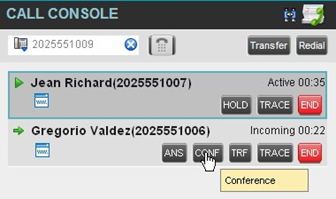
- Move the mouse over the non-selected call and click Conference . A Three Way Conference is established and the connected calls are moved to the Conference Call.
4.15.1. - Add Participant to Conference
To perform this operation, you need to have the N-Way Call service assigned.
To add participants to a conference:
- If the call you want to conference in is not yet established, place the call using any of the methods described in the Make and End Calls section.
- In the Call Console, move the mouse over the call to add and click Conference
 . The caller is added to the conference.
. The caller is added to the conference.
4.15.2. - Hold Conference
To put an active conference on hold:
In the Conference Call panel, click Hold Conference  . This allows other conference participants to continue their conversation.
. This allows other conference participants to continue their conversation.
4.15.3. - Resume Held Conference
To resume a held conference:
In the Conference Call panel, click Resume Conference  . All the calls in the conference become active.
. All the calls in the conference become active.
4.15.4. - Conference Participant on Hold
To put a specific conference participant on hold:
- Expand the Conference Call
- Move the mouse over the target call and click Hold
 .
.
4.15.5. - Resume Conference Participant
To resume a conference participant:
- Expand the Conference Call
- Move the mouse over the target call and click Answer
 .
.
4.15.6. - Leave Conference
To leave the conference:
In the Conference Call panel, click the Leave Conference button  .
.
4.15.7. - Remove Conference Participant
To end a selected call in the conference:
- Expand the Conference Call
- Move the mouse over the call and click End
 .
.
4.15.8. - End Conference
To end the conference:
In the Conference Call panel, click End Conference  . This releases all the calls that participate in the conference.
. This releases all the calls that participate in the conference.
4.15.9. - Barge in on Call
Call Barge-in allows you to barge in on a contact’s call. This is useful when you want to enter a call that is already established between two other people.
Depending on your setup, you can barge in on contacts in your group or enterprise.
To barge in on a call:
- Expand the Group/Enterprise or Favourites
- Click the target contact and click Barge In
 . The contact’s status must be Busy.
. The contact’s status must be Busy.
You enter an ongoing call, thereby establishing a Three-Way Conference. The calls appear in the Conference Call panel.
Alternatively, drag the call onto the target contact and click Barge In  for that contact.
for that contact.
You can now perform any conference operation on the call.
4.16. - Record Calls
To record calls, you have to have the Voice Recording service assigned and configured against the User in the Business Portal. Depending on the setting selected in the BP, calls may be automatically recorded.
If you want to record manually from this client then you need to ensure the user setting of On Demand with User Initiated Start is set in the Business Portal. Receptionist will then allow you to manually start, pause, resume, or stop recording a call.
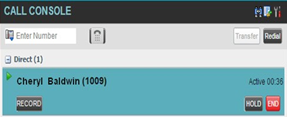
When a call is being recorded, the recording state, (which can be either Recording or Paused) appears on the line for the call.

4.16.1. - Start Call Recording
To manually record calls, you have to have your Call Recording service mode set to the On Demand or On Demand with User Initiated Start.
To record a call, select the call in the Call Console and click Record  .
.
In the On Demand mode, the call is recorded from the beginning, and you have to request the recording before the end of the call to keep the recording. In the On Demand with User Initiated Start mode, the recording starts from the moment when you click the Record button.
4.16.2. - Pause and Resume Call Recording
To pause and resume a recording, you have to have your Call Recording service mode set to On Demand, On Demand with User Initiated Start, or Always with Pause/Resume.
To pause a recording, select a call that is being recorded in the Call Console and click
Pause  .
.
The recording pauses until you resume it or the call ends.
To resume a paused recording, select a call whose recording has been paused in the Call
Console and click Resume  .
.
When you pause and resume a recording, only one call recording is generated for the call.
4.16.3. - Stop Call Recording
You can only stop recording a call if your Call Recording service mode is set to the On Demand with User Initiated Start.
To stop recording a call, select the call that is being recorded (or whose recording has been paused) in the Call Console and click Stop  .
.
If you click Start after a call recording has been stopped, a separate recording is created.
4.17. - Message Contacts (Enterprise Edition)
Receptionist allows you to send e-mail messages to contacts that have messaging configured in the system.
4.17.1. - Send E-mail to Contact
To send an e-mail message to a contact:
- In the Group/Enterprise, Favourites, Custom, or Monitored Contacts directory, click the contact that has an e-mail address configured.
- Click the E-mail button
 for the contact. This brings up a new e-mail window for the configured Messaging service.
for the contact. This brings up a new e-mail window for the configured Messaging service. - Write your message and click Send.
4.18. - Monitor IM&P Contacts and Chat with Contacts
With IM&P you can chat with other IM&P users and see the unified IM&P presence state of selected IM&P users directly from Receptionist.
The unified presence state of a contact is their combined instant messaging presence state when they are logged in through multiple devices or applications.
You have to be online to use IM&P capabilities of Receptionist.
4.18.1. - Monitor IM&P Contacts
To view the presence state of an IM&P contact, you first have to subscribe to the contact. Otherwise, Receptionist displays the contact’s state as Unsubscribed. If you send a subscription request to a contact and you are waiting for a reply, Receptionist displays the contact’s state as Pending Subscription.
The following directories display the IM&P state of contacts: Instant Message, Enterprise/Group, Favourites, Custom, and Search (for contacts from directories that display in the IM&P state).
NOTE: The Instant Message tab does not include IM&P contacts in the Unsubscribed state.
You can subscribe to a contact either by sending a subscription request to the contact or by adding the contact to the Instant Message directory.
For information about the operations related to subscribing to contacts and viewing their presence state, see the following sections:
- Subscribe to Contact
- Add Contact to Instant Message Directory
- Modify Contact
- Unsubscribe from Contact
- Accept or Reject Subscription Request
- View Presence State of Contacts
4.18.2. - Subscribe to Contact
To send a subscription request to a contact:
- Click the IM&P presence icon of an unsubscribed contact in any directory where the presence state of contacts is displayed. The Contact (IM) Subscribe dialog box appears.

-
Click Yes.
A subscription request is sent to the contact, and the contact is added to the Instant Message directory. The contact’s state is set to “Pending Subscription” .
When the subscription is accepted, the contact’s presence state is updated to their actual presence state. -
To resend a subscription request at any time, click the contact’s presence icon again and click Resend in the dialog box that appears.

4.18.3. - Add Contact to Instant Message Directory
When you add a contact to the Instant Message directory, the system automatically sends a subscription request to the contact.
To add a contact to the Instant Message directory:
- In the Instant Message tab, click Edit . The Edit Instant Message Contacts dialog box appears.
- Click Add. A new line is added below the existing entries, allowing you to define a new entry.
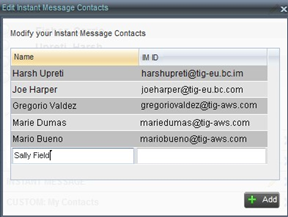
- In the Name text box, enter the display name of the contact to add.
- In the IM ID text box, enter a valid IM&P ID of the contact.
- To save the changes, click anywhere in the dialog box outside the entry.
A subscription request is sent to the contact, the contact’s presence state is set to “Pending Subscription”, and the contact is added to the Instant Message tab.
If the contact accepts your request, then the contact’s state changes to the actual presence state.
4.18.4. - Modify Contact Name
You can modify the display name of an existing contact.
To modify the display name of a contact:
- In the Instant Message tab, click Edit
 . The Edit Instant Message Contacts dialog box appears.
. The Edit Instant Message Contacts dialog box appears. - Double-click the contact and enter the new name in the Name text box.
- To save your changes, click anywhere in the dialog box outside the entry.
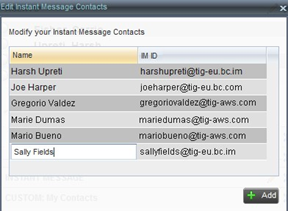
4.18.5. - Unsubscribe from Contact
To stop monitoring a contact:
- Click the presence icon of the contact. The Contact (IM) Unsubscribe dialog box appears.

- Click Yes. The contact is removed from the Instant Message directory and its presence status changes to Unsubscribed in other directories.
4.18.6. - Accept or Reject Subscription Request
When you receive a request from another user, a dialog box appears allowing you to accept or deny the request.

To accept the request, click Yes. If the contact is not yet in your Instant Message directory, a request is sent to add the user to the directory.
To reject the request, click No.
You can also close the dialog box and ignore the request. If you ignore the request, the dialog box will reappear the next time you go online.
4.18.7. - View Presence State of Contacts
You can view the presence state of IM&P contacts in the Instant Message,
Enterprise/Group, Favorites, Custom, and Search tabs. The presence icon is displayed to the left of the contact’s name.
Receptionist displays the unified instant messaging presence states, which indicates your contacts’ availability to communicate using client applications.
The actual unified presence state of a contact is displayed only if you are subscribed to the contact. Otherwise, the contact’s state is displayed as Unsubscribed or Pending Subscription.
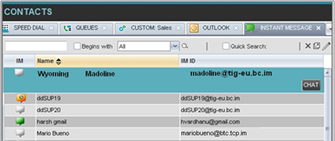
The following table lists the possible unified presence states of contacts in Receptionist:
|
IM&P State |
Icon |
Description |
|
Subscribed States |
||
|
Available |
 |
The contact is online, available on one or more devices, and not busy on any device. |
|
Busy |
 |
The contact is online, but currently busy on one or more devices. Do not disturb. |
|
Away |
 |
The contact is connected but away from one or more devices and not busy on any device. |
|
Offline |
 |
The contact is offline on all devices. |
|
Unsubscribed States |
||
|
Pending Subscription |
 |
You sent a subscription request to the contact, but it has not yet been accepted. Clicking the icon resends the request. |
|
Not subscribed |
 |
The contact has the IM&P service but you are not subscribed to monitor their state. The contact does not appear in the Instant Message tab. Clicking this icon sends a subscription request to the contact. |
4.18.8. - Chat with IM&P Contacts
You can chat with more than one contact at the same time, either in one-on-one sessions or by participating in multiuser chats. Each session requires a separate window.
Chat windows appear at the bottom-right hand side of the Receptionist main interface. Subsequent windows open to the left of the latest opened Chat window.
Chat windows can be taken out of the main interface and placed elsewhere on the screen.
The number of concurrently open Chat windows depends on the browser window size and screen resolution. The oldest Chat window is closed when there is no more room for a new Chat window to open. This only applies to Chat windows that are placed within the main interface.
You can start a chat session with a contact or accept a request from another user. A oneon-one session can be converted into a multiuser chat by inviting more participants. You can also receive an invitation to a multiuser chat from another user.
When your IM&P contact is in your group/enterprise, you can phone them directly from the Chat window.
The tasks related to instant messaging are described in the following sections:
- Start Instant Messaging Session
- Place Call from Chat Window
- Establish Multiuser Chat Session
- Manage Instant Messaging Sessions
4.18.9. - Start Instant Messaging Session
You can start an instant messaging session with an IM&P contact from any of the following directories: Instant Message, Enterprise/Group, Favorites, Custom, and Search.
To start an instant messaging session with a contact:
- In the Contacts pane, click the target contact. The entry expands displaying available action buttons.
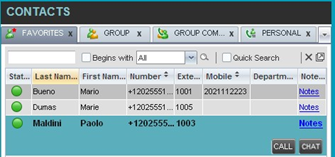
-
Click Chat
 on the line for the contact. A Chat window appears, displaying your contact’s information on the title bar.
on the line for the contact. A Chat window appears, displaying your contact’s information on the title bar.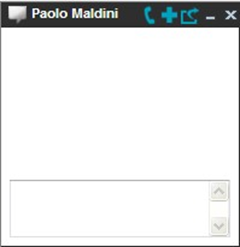
NOTE: A Chat window also appears when another IM&P user initiates a chat session with you. -
Type your message in the text box at the bottom of the window and click ENTER on the keyboard. Your message is sent to your contact.
The messages you send and receive appear in the Chat Logs area at the top of the window, below the title bar. Up to 50 messages per contact are kept in the log for the duration of your IM&P session, even if you close the Chat window and later start exchanging messages again with the same contact. The messages are cleared when you go offline.
4.18.10. - Place Call from Chat Window
If the user with whom you are chatting is also a contact in your Group/Enterprise directory, you can call the contact directly from the Chat window.
To place a call from the Chat window:
Click the Call button  at the top right-hand side of the Chat window.
at the top right-hand side of the Chat window.
The Receptionist client issues a Click-To-Dial attempt to the contact’s phone number and the call appears in the Call Console.
4.18.11. - Establish Multiuser Chat Session
You can invite other contacts to your chat session, thus converting your one-on-one chat to a multiuser chat. An incoming multiuser chat invitation opens a window for a new multiuser chat.
To add users to a chat:
- Click the Add User to Chat button in the Chat A drop-down list of available contacts appears.
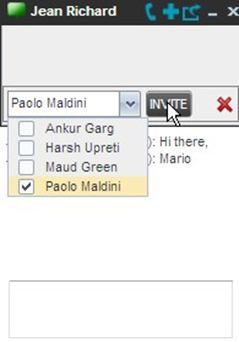
- Select the check box next to each contact to invite and then click the Invite When a contact joins the chat, a notification appears in the Chat Logs area of the Chat window. The participants (other than you) are also listed at the top of the window.
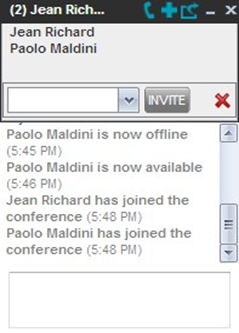
-
To leave the multiuser chat, close the Chat
4.18.12. - Manage Instant Messaging Sessions
If a Chat window is not in focus and an incoming message is available for you to read, the color of the window is light brown as shown in the following figure. This changes back to black as soon as the window is in focus.
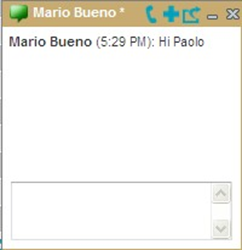
You can also close, minimize, or pop out a Chat window, that is, take the Chat window out of the Receptionist main interface and place in elsewhere on the desktop.
To pop out a Chat window:
Click the Pop-out button  at the top right-hand side of the window.
at the top right-hand side of the window.
The window is placed on the desktop outside of Receptionist main interface and the Popout button becomes the Pop-in button.
To place the window back within the Receptionist main interface:
Click the Pop-in button  at the top right-hand side of the window.
at the top right-hand side of the window.
To minimize or close a Chat window:
Click the Minimize or Close button at the top right-hand side of the window. When a window is closed, the windows to the left (if present) shift to the right. This only applies to Chat windows that are placed within the Receptionist main interface.
4.19. - Manage Contacts
Receptionist allows you to view, search, and organize your contact directories.
You use the Contacts pane to manage your contact directories, to monitor selected contacts, and to use your contacts to make or manage calls.
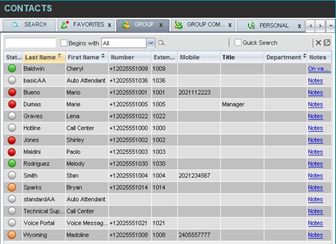
This section describes the directories management functions provided by Receptionist.
- Show/Hide Directories
- View Directory Content
- Search Contacts
- Order Directory Entries
- Make Notes about Contact (Enterprise Edition)
- Manage Personal Contacts
- Manage Speed Dial Entries
4.20. - Show/Hide Directories
Receptionist allows you to specify which directory tabs should be visible in the Contacts pane.
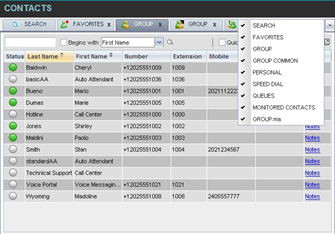
To display or hide a directory tab in the Contacts pane:
- At the top right-hand side of the Contacts pane, click the drop-down arrow .
- From the list that appears, select the directory to display. The selected directory appears and its tab is displayed at the top of the Contacts
To hide a directory tab, click the Close button  on that directory’s tab.
on that directory’s tab.
Note that once you close a directory containing search results, you cannot display it again by selecting it from the list.
4.21. - View Directory Content
Your directories are displayed as tabs at the top of the Contacts pane, with the details of only one directory visible at a time. The information displayed about each contact depends on the directory you are viewing.
To view contacts in a directory:
In the Contacts pane, click the tab for that directory. The directory listing appears in the Contacts pane.
To view additional information about a contact:
Click the contact to view. This expands the row for the contact displaying applicable action buttons and in some directories also the contact’s Exchange calendar. For more information about the action buttons, see Call Action Buttons. For more information about the contact’s calendar, see Monitored User’s Calendar (Enterprise and Small Business Editions).
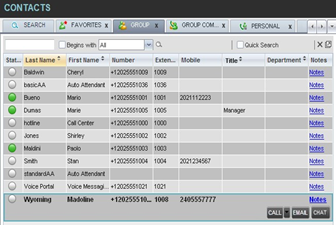
Only one contact can be expanded at a time. When you click a contact, the system automatically hides the details of the previously expanded contact.
4.22. - Search Contacts
Receptionist allows you to search for contacts several different ways. You can perform a search on a specific directory or on all directories at once. You can perform a regular search or a quick search, and you can create a new directory from search results.
You use the following procedures to search for contacts:
- Perform Quick Search
- Perform Regular Search
- Create Directory from Search Results
- Perform Search on Search Results
4.22.1. - Perform Quick Search
A quick search searches on a specific column in a selected directory for entries that start with a character entered by you. The column on which the search is performed is the column by which the directory is currently ordered.
A quick search can be performed on any directory, but is not available in the Search tab.
NOTE: The search is not case-sensitive; the search for “Ann” and “ann” returns the same results.
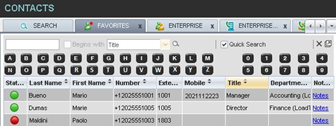
To perform a quick search:
- Click the directory tab where you want to perform the search.
- Order the directory by the column on which you want to perform the search.
- Check the Quick Search
- From the keypad that appears, select a character (a single letter or digit) by which you want to search. The contacts that start with the selected character (in the selected column) are displayed in the directory.
- To perform another search on the same column, select another character. The new search is performed on the original directory and not on the results of the previous search.
4.22.2. - Perform Regular Search
You can search for contacts in a specific directory or in all directories at once.
When you search for contacts in a specific directory, you can search on a specific column or on all columns. When you use the Search tab, the search is always performed on all directories and columns.
NOTE: The search is not case-sensitive; the search for “Ann” and “ann” returns the same results.
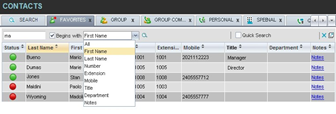
To search in a specific directory:
- Select the directory.
- Make sure that the Quick Search box is unchecked.
- In the Search text box, enter the text for which you want to search. You can enter partial information, such as part of a name or phone number, but you must enter at least two characters.
For example, if you do not remember whether Mary’s last name is spelled “Shelley” or “Shelly”, you can enter “Shell”, and either name is returned.
- To restrict the search to contacts that start with the entered string, check the Begins with Otherwise, the search results also include contacts that contain the entered string.
- From the drop-down list, select the column by which you want to search. You can select a specific column or all columns.
- Click the Search button
 .
.
The text you entered is matched against the selected column (or all columns) of every entry of the selected directory. Search results are displayed in the tab where the search was performed.
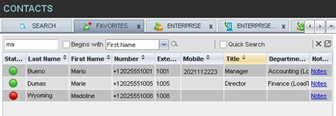
Duplicate search results in ICtalk3 directories are not displayed; the first match for a given contact is displayed.
Duplicate search results in other directories being displayed.
The search returns either all the contacts (in the selected directory) that contain the entered keyword or all the contacts that start with the entered keyword.
In the first case (Begins with not checked), entering “Ann” returns all contacts with the name “Ann”, but it also returns all contacts with names such as “Anne”, “Marianne”, “Marie Ann”, “Ann Marie”, and so on.
In the second case (Begins with checked), entering “Ann” returns all contacts with names such as “Ann”, Anne”, and Ann Marie”, but not “Marianne” or “Mary Ann”.
- To clear the search results, click Reset
 .
.
To search in all directories:
- Click the Search tab.

-
In the Search text box, enter the text for which you want to search. You can enter partial information, such as part of a name or phone number, but you must enter at least two characters.
-
For example, if you do not remember whether Mary’s last name is spelled “Shelley” or “Shelly”, you can enter “Shell”, and either name is returned.
-
To restrict the search to contacts that start with the entered string, check the Begins with Otherwise, the search results also include contacts that contain the entered string.
-
Click the Search button
 .
.
The text you enter is matched against all columns in all directories (except for the Notes column). Search results are displayed in the Search tab.
Duplicate search results in ICtalk3 directories are not displayed; the first match for a given contact is displayed. Duplicate search results in other directories are displayed.
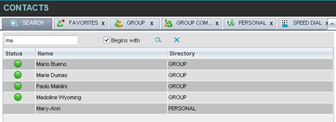
- When you click a contact, the entry expands displaying contact details. The information depends on the directory for which the contact was selected.
NOTE: Contact entries displayed in the Search tab follow the same rules as if that entry was accessed in its own directory. This allows you to perform any operations directly from the search results.
4.22.3. - Create Directory from Search Results
When you perform a search in a directory, you can create a new directory from the search results, using the Pullout button. The button is enabled when a search is performed on a single field.
NOTE: The Pullout button is not available in the Search directory.
To create a directory from search results:
- Select the directory where you want to perform the search.
- Perform a quick search or enter the search criteria.
- When the results are displayed, click the Pullout button
 , which becomes active. A new tab is created containing the results of the search.
, which becomes active. A new tab is created containing the results of the search.
NOTE: Contact entries displayed in a search results tab follow the same rules as if that entry was accessed in its own directory. This allows you to perform operations directly from the search results.
4.22.4. - Perform Search on Search Results
If you perform a search in a specific directory, the search is always performed on the entire directory even if only search results are displayed. To search in search results, you first need to create a new directory from the search results.
To perform a search on search results:
- After you perform the original search, create a directory from the search results.
- Perform a new search in the new directory.
NOTE: Searching within the search results cannot be performed on the same column that the original search was performed.
4.23. - Order Directory Entries
Receptionist allows you to order directory entries is ascending or descending order. The columns by which the directory can be ordered have the sort icon  displayed next to their name. The following table lists the directories and the columns by which they can be ordered.
displayed next to their name. The following table lists the directories and the columns by which they can be ordered.
|
Directory |
Sort Columns |
Default Sort Column |
|
Enterprise/Group |
First Name, Last Name, Department |
Last Name |
|
Favourites |
First Name, Last Name, Number, Mobile, Extension, Notes, Department, Status, IM, Title |
Last Name |
|
Group/Enterprise Common |
Name, Number |
Name |
|
Personal |
Name, Number |
Name |
|
Speed Dial |
Code, Description, Number |
Code |
|
Queues |
Name, Number, Extension, Department |
Name |
|
Custom |
First Name, Last Name, Department |
Last Name |
|
Outlook |
Last Name, First Name, Number, Mobile, Home Phone |
Last Name |
|
Instant Message |
Name, IM ID, IM |
Name |
|
Monitored Contacts |
First Name, Last Name, Number, Mobile, Extension, Notes, Department, Status, IM, Title |
Last Name |
Note that you cannot order the contacts in the Search directory.
The sorting order for the Status column is as follows (from highest to lowest): Private, On a Call, Ringing, Away, In a Meeting, Call Forwarding Always, Do Not Disturb, and
- For information on the different states, see Monitored User States.
The sorting order for the IM column is as follows (from highest to lowest): Busy, Away, Available, Offline, Pending Subscription, Not subscribed. For information on the different states, see Unified Instant Messaging and Presence States.
To order a directory:
- Click the header of the column by which you want to order the directory.
- To reverse the order, click the same column header again.
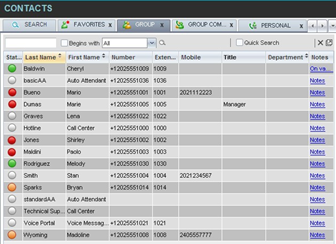
The contacts in the selected directory are reordered based on the selected column. The sort order is saved on sign-out and preserved between sessions.
4.24. - Make Notes about Contact (Enterprise Edition)
Receptionist Enterprise allows you to make notes about the contacts in your Group/Enterprise, Favourites, or Monitored Contacts directory.
To make a note about a contact:
- In the Group/Enterprise, Favourites, Custom, or Monitored Contacts directory, click the Notes The Notes for <Contact Name> dialog box appears.
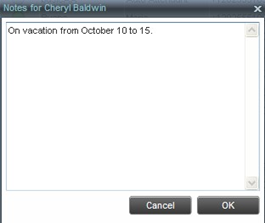
-
Enter the desired text or view or modify the existing text in the Notes text box.
-
To save your changes and close the dialog box, click OK.
To close the dialog box without saving, click Cancel.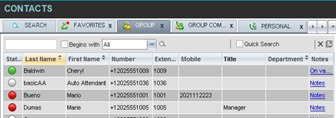
4.25. - Manage Personal Contacts
You can add or remove personal contacts via the web portal or in Receptionist, and the updates appear in both places. However, the updates that you make via the web portal appear in Receptionist at the next sign-in.
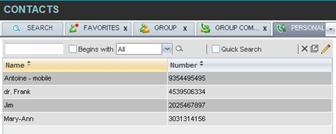
You can perform the following operations on personal contacts:
- Add Personal Contact
- Delete Personal Contact
4.25.1. - Add Personal Contact
To add a personal contact:
- In the Personal tab, click Edit
 . The Edit Personal Contacts dialog box appears.
. The Edit Personal Contacts dialog box appears. - Click Add. A new line is added below the existing entries, allowing you to define a new entry.
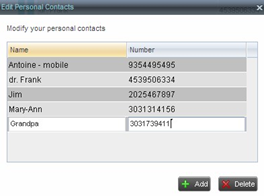
- In the Name text box, enter the contact’s name or description, as you want it to appear.
- In the Number text box, enter the phone number of the contact.
- To save the changes, click anywhere in the dialog box outside the entry.
4.25.2. - Delete Personal Contact
To delete a speed dial entry:
- in the personal/tab click Edit
 . The Edit Personal Contacts dialog appears.
. The Edit Personal Contacts dialog appears. - Click Delete.
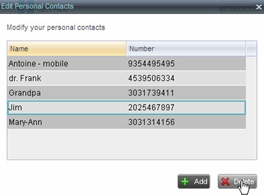
4.26. - Manage Speed Dial Entries
This directory is available in all editions of Receptionist. It allows you to manage and use your Speed Dial 8 and Speed Dial 100 entries. To use this feature, you need to have Speed Dial 8 and/or Speed Dial 100 service assigned. If you only have one of these services, you see the entries for that service only in your Speed Dial tab.
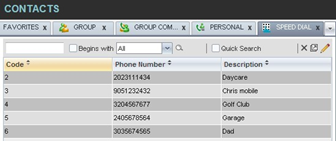
You can add or remove entries via the web portal or the Receptionist client, and the updates appear in both places. However, the updates that you make via the web portal appear only at the next sign-in to Receptionist.
To update speed dial entries using the client, perform the following operations:
- Add Speed Dial Entry
- Modify Speed Dial Entry
- Delete Speed Dial Entry
4.26.1. - Add Speed Dial Entry
To add a speed dial entry:
- In the Speed Dial tab, click Edit
 . The Edit Speed Dials dialog box appears.
. The Edit Speed Dials dialog box appears. - Click Add. A new line is added below the existing entries, allowing you to define a new entry.
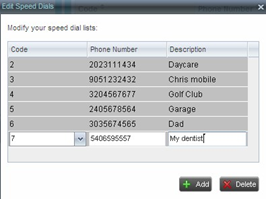
- From the Code drop-down list on the left, select a speed dial code.
- In the Phone Number text box, enter the phone number to assign to the code.
- In the Description text box, enter a description that allows you to identify the entry.
- To save the entry, click anywhere in the dialog box outside the entry.
4.26.2. - Modify Speed Dial Entry
To modify a speed dial entry:
- In the Speed Dial tab, click Edit
 . The Edit Speed Dials dialog box appears.
. The Edit Speed Dials dialog box appears. - Double-click the entry to modify. The entry becomes modifiable.
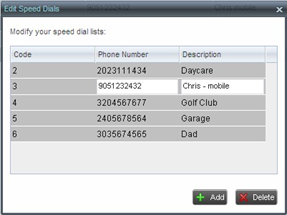
- Modify information as required.
- To save the changes, click anywhere in the dialog box outside the entry.
4.26.3. - Delete Speed Dial Entry
To delete a speed dial entry:
- In the Speed Dial tab, click Edit . The Edit Speed Dials dialog box appears.
- Select the entry to delete and click Delete.
4.27. - Monitor Contacts
Receptionist allows you to monitor the call state of selected contacts. All editions of Receptionist allow you to monitor contacts configured through the web portal. This is referred to as static monitoring. In addition, Receptionist Enterprise allows you to monitor selected contacts dynamically.
The following table summarizes the monitoring capabilities of the different editions of Receptionist:
|
Edition |
Description |
|
Enterprise |
This is the static monitoring of up to 200 contacts and the dynamic monitoring of a configurable number of contacts enterprise-wide. The maximum number of contacts you can dynamically monitor is configured by your administrator and it cannot exceed 100. |
|
Small Business |
This is the static monitoring of up to 30 contacts enterprise-wide. |
You use the Favourites tab to view the phone state of statically monitored contacts and the Group/Enterprise tab to view the phone state of dynamically monitored contacts.
NOTE: If a call is parked against the contact that you are monitoring, the information about the parked call also appears.
The following sections describe information and procedures related to monitoring contacts:
- Static Monitoring
- Dynamic Monitoring (Enterprise Edition)
- Request Dynamic Monitoring
- Monitored User’s Calendar (Enterprise and Small Business Editions)
- Contact States
4.27.1. - Static Monitoring
To statically monitor contacts, the list of contacts to monitor must be configured on your web portal. The selected contacts appear in your Favorites directory. However, the updates that you make to the list of contacts to monitor appear in Receptionist at the next sign-in.
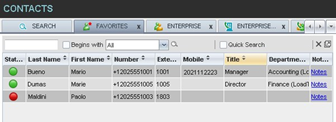
4.27.2. - Dynamic Monitoring (Enterprise Edition)
Dynamic Monitoring allows you to view the call state of selected contacts in your Group/Enterprise directory. You must request that a contact be monitored. Depending on the client customization, you may or may not be able to manually stop monitoring a contact. When the number of monitored contacts reaches the maximum limit, the system will either ask your permission to stop monitoring the oldest one (fourth) of the currently monitored contacts or will ask you to unselect one or more contacts yourself. The state of a contact that is not monitored is shown as Unknown.
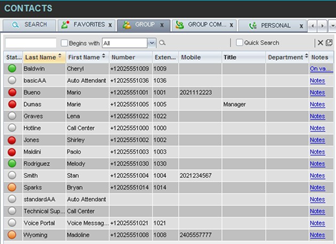
NOTE: If a contact in your Enterprise/Group directory is statically monitored, then their phone state is displayed without the need to explicitly request dynamic monitoring; however, it counts toward the total number of dynamically monitored contacts.
Request Dynamic Monitoring
The set of contacts that you dynamically monitor is stored as part of your context information and automatically retrieved and activated on subsequent sign-ins.
To monitor a contact:
In the Group/Enterprise directory, click the Status icon of the contact to monitor.
NOTE: You cannot monitor the state of virtual users. Only regular users can be monitored.
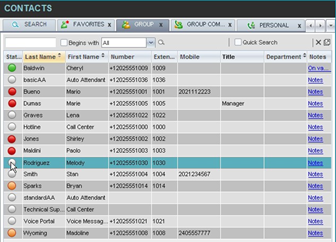
This requests state notifications from ICtalk3 for this contact; the contact’s state is updated in real time.
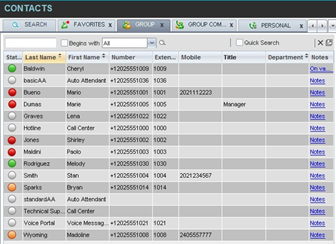
When the number of monitored contacts reaches the maximum limit, one of the following messages appears depending on your client configuration.

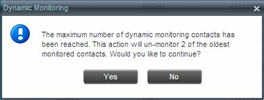
If your system allows you to unselect monitored contacts, unselect the contacts you no longer want to monitor and select new contacts for monitoring.
If your system does not allow you to unselect monitored contacts, click Yes to allow the system to stop monitoring the oldest one fourth of the currently monitored contacts and start monitoring the contact you requested. Click No to cancel the request.
4.27.3. - Monitored User’s Calendar (Enterprise and Small Business Editions)
When you expand the entry for a monitored contact, the entry displays calendar details for the contact, with information downloaded from the Microsoft Exchange server, if the Calendar Presence Integration feature is enabled.
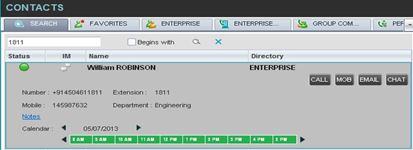
The calendar is divided into one-hour blocks. Those blocks can be displayed in red (when the user is busy), green (when the user is free), or partly in red and partly in green (when the user is busy only during part of the one hour block). When you move the mouse over a partially busy time block, the ToolTip shows the meeting’s start and end time (for example, 9:00 AM to 9:30 AM).
By default, the calendar displays the time between 8:00 AM and 6:00 PM for the current day. You can change the date and the time displayed on the calendar, by using the Back and Forward
and Forward  buttons. Clicking the button shifts the displayed time period by one day/hour. The calendar details are displayed in the time zone of your local machine.
buttons. Clicking the button shifts the displayed time period by one day/hour. The calendar details are displayed in the time zone of your local machine.
4.27.4. - Contact States
The state of a contact is represented by an icon located to the left of the contact’s name. This state integrates the state of the contact’s line, the contact’s Microsoft Exchange calendar presence, and the state of services such as Call Forwarding Always, Do Not Disturb, and Privacy. The following table lists the possible contact states.
|
Icon |
State in Receptionist |
DND |
CFA |
Privacy |
Exchange Calendar State |
Call State |
 |
Private |
N/A |
N/A |
On |
N/A |
N/A |
 |
On a Call |
N/A |
N/A |
Off |
N/A |
Active call |
 |
Ringing |
N/A |
N/A |
Off |
N/A |
Ringing call, no active calls |
 |
Away |
N/A |
N/A |
Off |
Out of Office |
No active calls |
 |
In a Meeting |
N/A |
N/A |
Off |
Busy |
No active calls |
 |
Call Forwarding Always |
N/A |
On |
Off |
Free or Tentative |
No active calls |
 |
Do Not Disturb |
On |
Off |
Off |
Free or Tentative |
No active calls |
 |
Available |
Off |
Off |
Off |
Free or Tentative |
No active calls |
 |
Unknown |
N/A |
N/A |
N/A |
N/A |
N/A |
NOTE: When a contact enables Privacy, this terminates monitoring of the contact’s state for the current login session. To be able to monitor their state again, you must sign out and then sign in after the contact has disabled Privacy.
4.28. - Manage Call History
You can organize call logs and delete selected call logs or all call logs from Call History.
4.28.1. - View Call History
Receptionist allows you to view your passed calls. By default, the calls are grouped into placed, received, and missed calls.
NOTE: The format in which date and time are displayed in the Call History dialog box depends on the date and time settings selected on the Settings – General configuration page. For details, see Date Format and Time Format.
To view your call history:
- In the Call Console, click the Call History button
 . The Call History dialog box appears displaying your past calls. The calls are grouped into placed, received, and missed calls. By default, missed calls are displayed.
. The Call History dialog box appears displaying your past calls. The calls are grouped into placed, received, and missed calls. By default, missed calls are displayed.
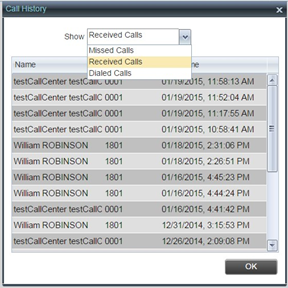
-
To show calls in a specific group, select that group from the Show drop-down list.
4.28.2. - Delete Call History
You can delete a selected call log or all call logs from Call History.
To delete call logs from Call History:
- In the Call Console, click the Call History button
 . The Call History dialog box appears.
. The Call History dialog box appears. - To delete all call logs, click Delete All .
- From the Show drop-down list, select a grouping.
- To delete a selected log, click Delete Call
 Log for that log.
Log for that log.
4.29. - Manage Queued Calls (Enterprise Edition)
Receptionist allows you to manage calls in selected call centers (up to five) and monitor calls in real time. You manage queued calls using the Queued Calls pane. This functionality is only available if you have the Receptionist – Enterprise license assigned and either you are assigned to a call center (as a supervisor or agent) or you have the ICtalk3 Supervisor license assigned.
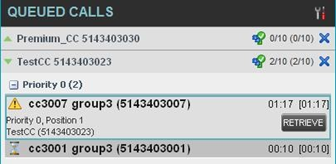
This section describes the following procedures you perform to manage queued calls:
- Select Call Centers to Manage
- Modify Number of Calls to Display
- Retrieve Call from Queue
- Transfer Call to Ad Hoc Number
- Transfer Call Between Queues
- Transfer Call to Top of Queue (Premium Call Center)
- Promote Call in Queue (Premium Call Center)
- Group Calls
- Order Queued Calls
4.29.1. - Select Call Centers to Manage
After you sign in to Receptionist, select the call centers you want to manage (up to five).
To select call centers:
- In the Queued Calls pane, click Options
 and select the Edit Queue Favourite Dialog option
and select the Edit Queue Favourite Dialog option

The Edit Queue Favourites dialog box appears.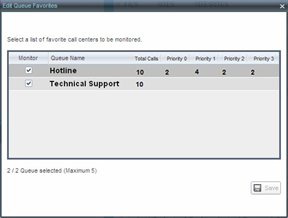
- Select the check boxes for the call centers you want to monitor.
- Click Save.
The selected call centers appear in your Queued Calls pane.
4.29.2. - Modify Number of Calls to Display
For each Standard call center that you are monitoring, you can modify the maximum number of calls to be displayed. For each Premium call center, you can modify the maximum number of calls that can be displayed in each priority bucket. The total number of calls to display for a call center cannot exceed 50.
- In the Queued Calls pane, click Options
 and select the Edit Queue Favorite Dialog The Edit Queue Favorites dialog box appears.
and select the Edit Queue Favorite Dialog The Edit Queue Favorites dialog box appears. - For each Standard call center you are monitoring, set the total number of calls to display.
- For each Premium call center you are monitoring, set the number of calls to display in each priority bucket. The total number of calls in all priority bucket cannot exceed 50.
4.29.3. - View Queued Calls
To view calls in a queue:
Click the Expand button  for that queue.
for that queue.
4.29.4. - Retrieve Call from Queue
You can retrieve a call from a queue to your phone device.
To retrieve a call from the queue:
In the Queued Calls pane, click the call to expand it and click Retrieve  for that call.
for that call.
Once you retrieve the call, the call appears in the Call Console, and you treat it as any other call.
4.29.5. - Transfer Call to Ad Hoc Number
To transfer a call to an ad hoc number:
- In the Queued Calls pane, select the call.
- In the Dialer, enter the destination number and click Transfer
 .
.
The call is transferred and removed from the queue.
4.29.6. - Transfer Call Between Queues
To transfer a call to another queue:
- In the Queued Calls pane, select the call.
- In the Contacts pane, expand the Queues
- Click the target queue and click Transfer
 for that queue.
for that queue.
The call is transferred and removed from the original queue.
4.29.7. - Change Position of Call in Queue
To change the position of a call in the queue:
- In the Queued Calls pane, click the call and click Reorder
 .
. - In the drop-down box that appears, select the new position in the queue. The call is placed at the new position.

NOTE: The list can contain a maximum of 24 reorder positions that you can choose from to reorder a call in the queue, in addition to the Send to Back and Sent to Front options.
4.29.8. - Order Queued Calls
Queued calls can be ordered according to their total waiting time or according to their waiting time in the current priority bucket.
To order queued calls:
- In the Queued Calls pane, click Options
 .
. - Select Sort and then the ordering option you want. This operation applies to all monitored call centers.

NOTE: The ordering does not work when calls are grouped. If required, first ungroup the calls.
4.30. - Keyboard Shortcuts
When using keyboard shortcuts, make sure that the main interface window is in focus.
|
Key |
Equivalent Mouse Action |
Description |
|
ESC |
Click the Close button |
This closes the open dialog box. |
|
ESC |
Cancel the changes. |
This exits the currently selected editable item, such as a text box. |
|
/ |
Click the Dialer text box. |
This places the cursor in the Dialer text box; it retains the currently selected item (if applicable). NOTE: In Internet Explorer 8, the “/” shortcut key does not always work. Pressing the key clears the default Enter Number text, but does not place the cursor in the input box. |
|
? |
Click the Search text box. |
This places the cursor in the Search text box; it retains the currently selected item (if applicable). |
|
ARROW DOWN |
Click the scroll bar or the next item in a list. |
This selects the next item in the Call Console or Queued Calls pane. |
|
ARROW UP |
Click the scroll bar or the previous item in a list. |
This selects the previous item in the Call Console or Queued Calls pane. |
|
PAGE DOWN |
Scroll down one page. |
This goes to the next page in the Call Console or Queued Calls pane. |
|
PAGE UP |
Scroll up one page. |
This goes to the previous page in the Call Console or Queued Calls pane. |
|
1….9 |
Select a call in the Call Console. |
Pressing “1” selects the first call, pressing “2” selects the second call, and so on. |
|
SPACEBAR |
Click Answer on the selected incoming call in the Call Console. |
This answers the selected incoming call or if no call is selected, the incoming call that has been waiting the longest. Pressing the SPACEBAR again answers the next longest waiting incoming call, which puts the previously answered call on hold. |
|
<PERIOD> |
Click End on a selected call in the Call Console. |
This ends the selected call. |
|
ENTER |
Click Dial. |
If the cursor in placed in the Dialer text box, the entered digits are dialed. |
|
ENTER |
Click Search. |
If the cursor is placed in the Search text box, a search is performed. |
|
Click Transfer in the Dialer. |
This transfers the selected call to the ad hoc number entered in the Dialer. |
|
|
SHIFT 1..9 |
Select a ringing call and click Answer. |
Pressing SHIFT 1 selects and answers the first ringing call, pressing SHIFT 2 selects and answers the second ringing call, and so on. |
|
SHIFT 1..9 |
Select an active call and click Hold. |
Pressing SHIFT 1 selects and then places the first active call on hold. Pressing SHIFT 2 selects and then answers the second active call, and so on. |
|
SHIFT 1..9 |
Select a held call and click Retrieve. |
Pressing SHIFT 1 selects and retrieves the first held call, pressing SHIFT 2 selects and retrieves the second held call, and so on. |
|
S or s |
Click on Settings link. |
This opens the Settings page if main window is in focus. |
|
B or b |
Click on Back to Application link. |
This goes back to the main page from the Settings page. |
|
R or r |
Click the Call History button. |
This opens the Call History dialog box. |
|
H or h |
Click the Help link. |
This opens this guide in a PDF format. |
|
SHIFT L or SHIFT l |
Click the Sign Out link. |
This signs the user out of the application. |











 Options
Options Expand/Collapse
Expand/Collapse Close
Close Edit
Edit Call History
Call History Call Waiting
Call Waiting Auto Answer
Auto Answer End Conference
End Conference Leave Conference
Leave Conference Hold Conference
Hold Conference Resume Conference
Resume Conference Web Pop URL
Web Pop URL Pull Out
Pull Out Clear Search
Clear Search Group Queues
Group Queues Web Pop URL
Web Pop URL vCard
vCard Transfer to Voice Mail
Transfer to Voice Mail Call
Call Add User to Chat
Add User to Chat Invite
Invite Pop-out
Pop-out Pop-in
Pop-in Minimize
Minimize Close
Close Dial
Dial
 Redial
Redial Mobile
Mobile E-mail
E-mail Transfer
Transfer Transfer
Transfer Transfer to Voice Mail
Transfer to Voice Mail Answer
Answer Hold
Hold End
End Conference
Conference Camp
Camp Barge In
Barge In Park
Park Record
Record Pause
Pause Resume
Resume Stop
Stop Monitor
Monitor Chat
Chat Promote
Promote Retrieve
Retrieve Reorder
Reorder Web Pop URL
Web Pop URL Delete Call Log
Delete Call Log in a dialog box.
in a dialog box.